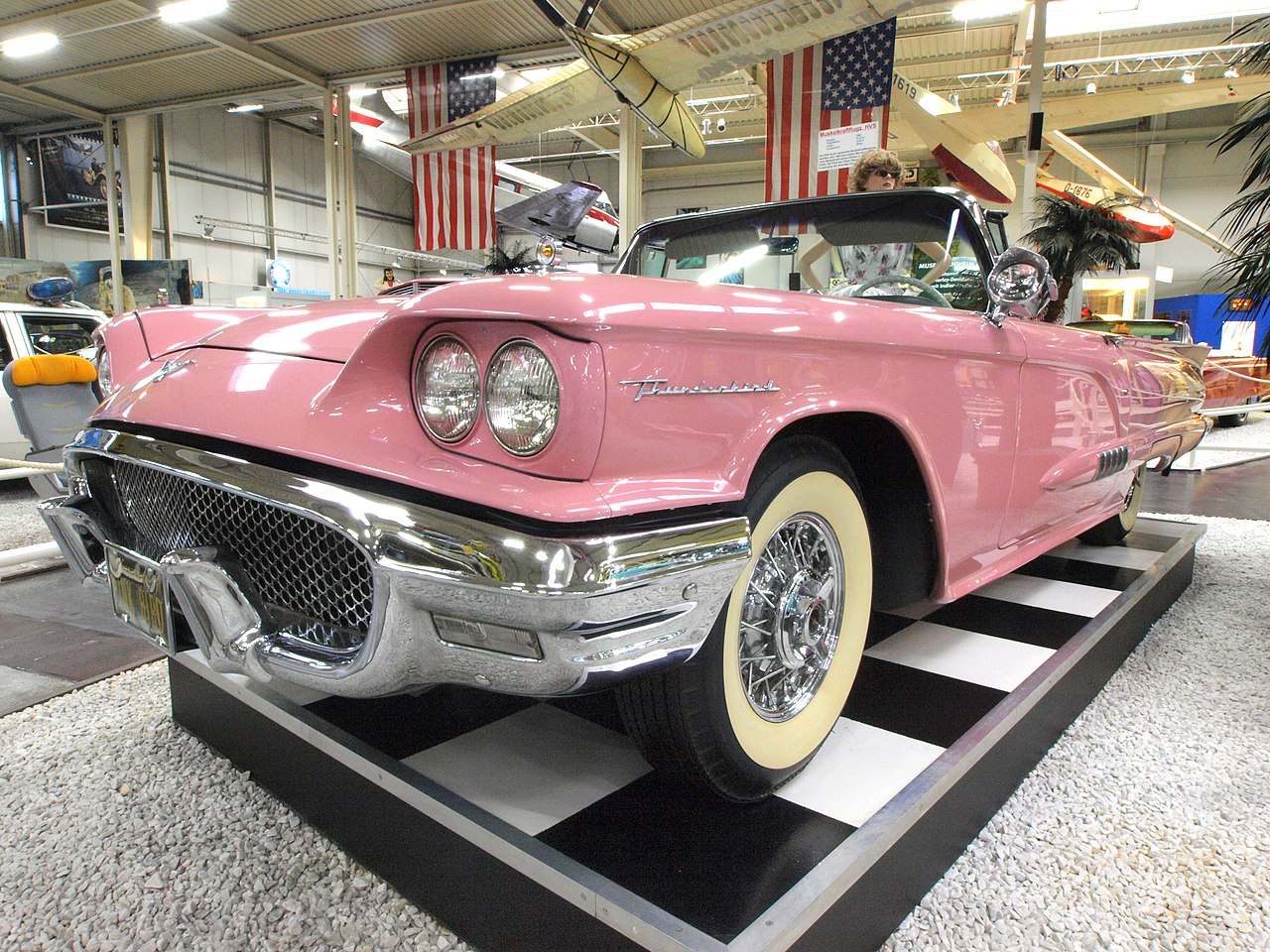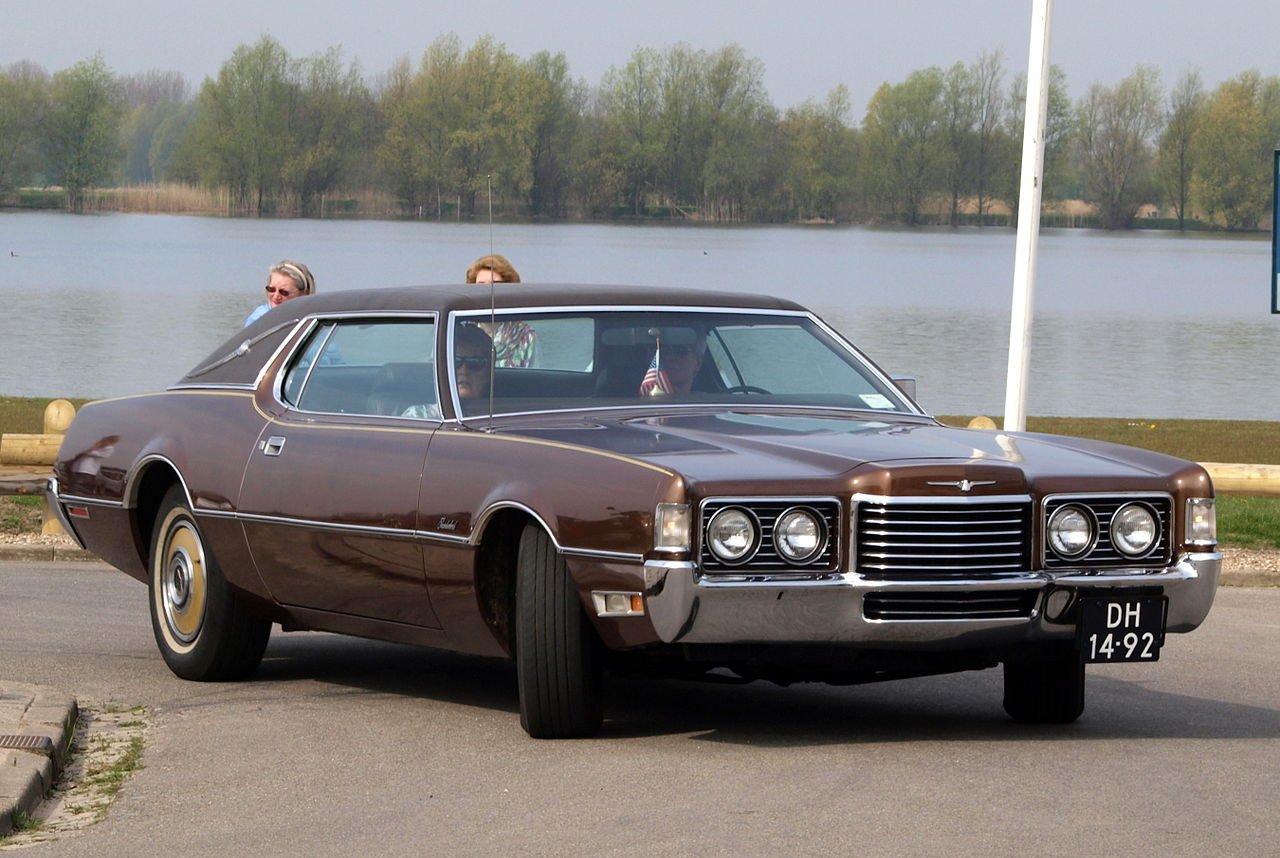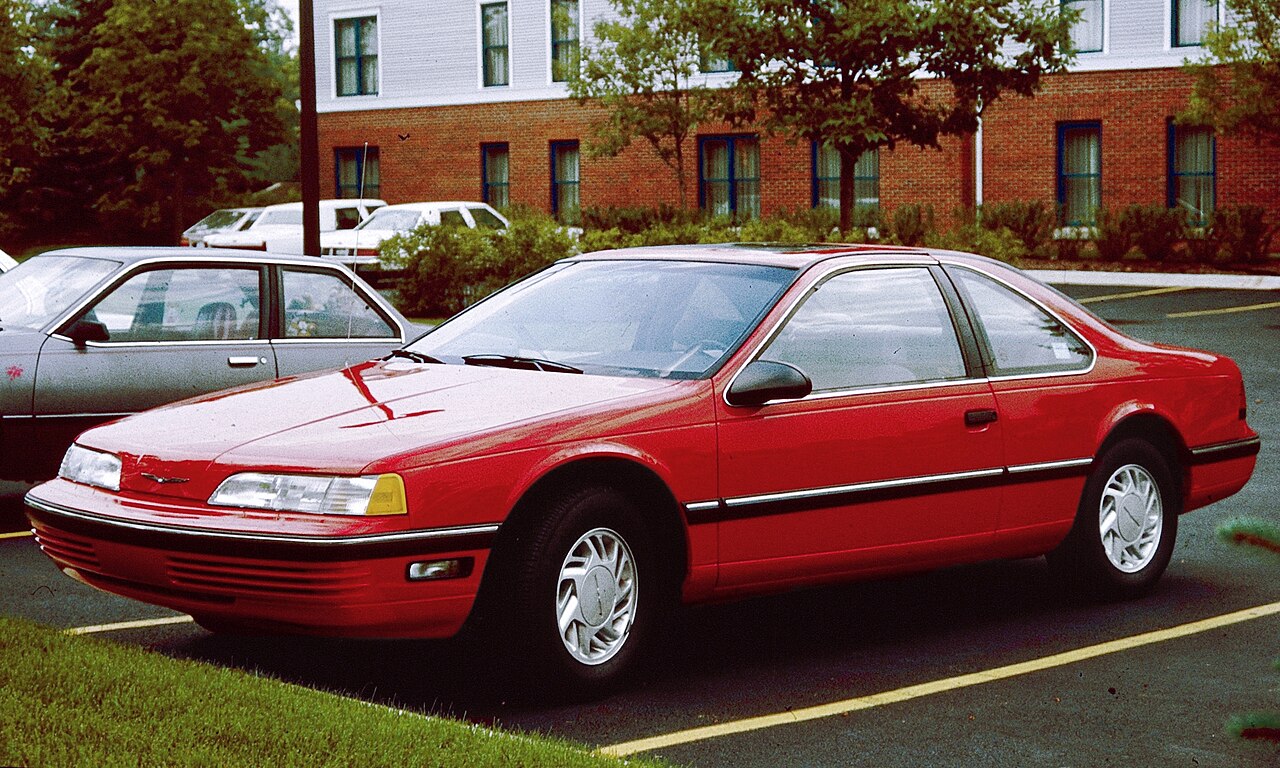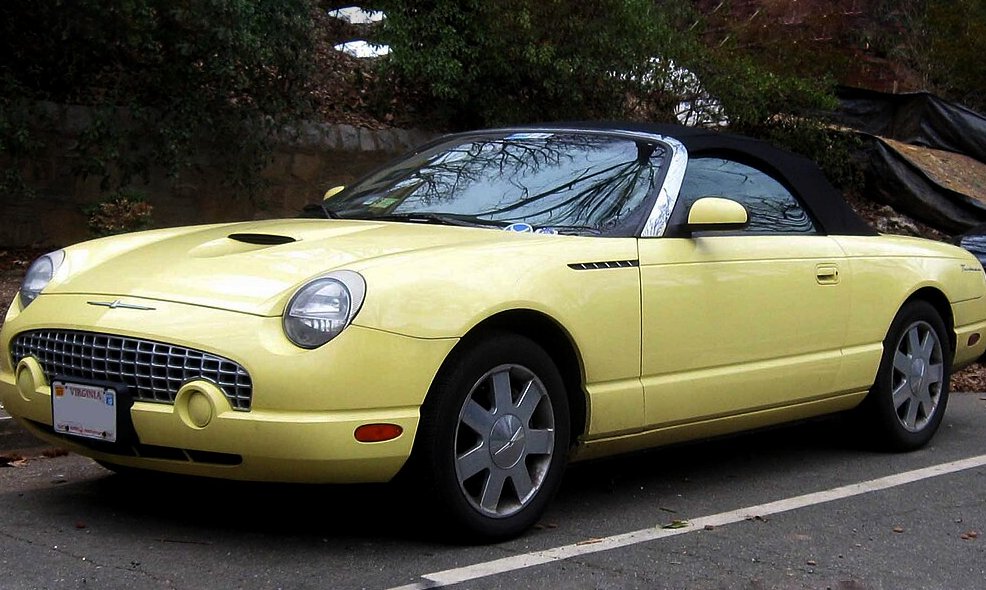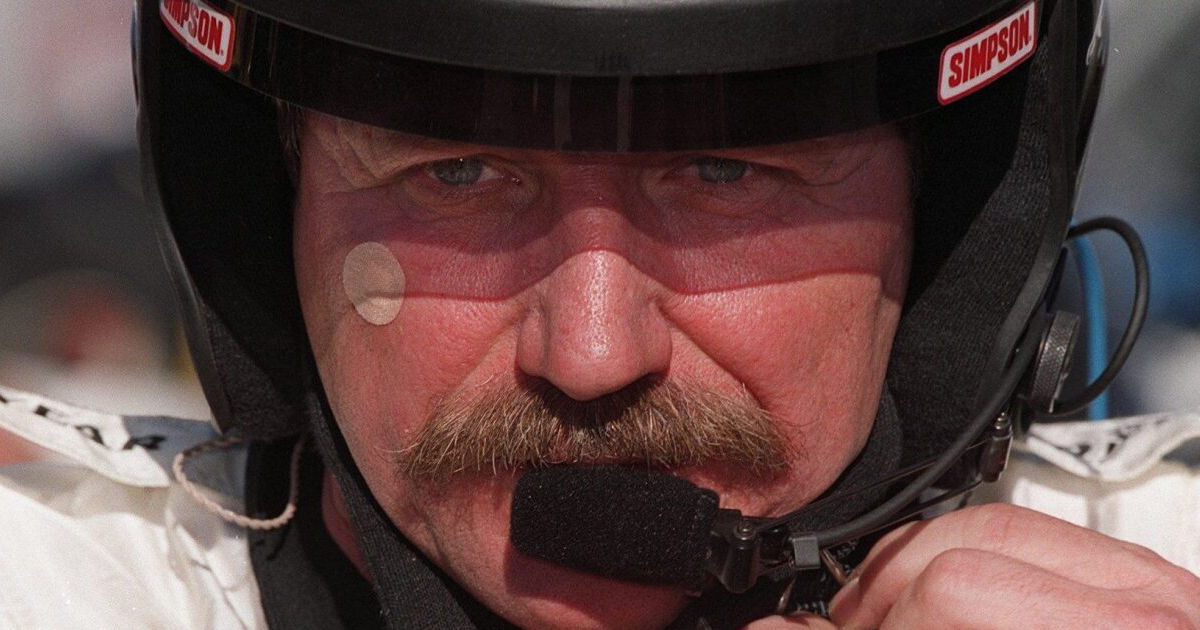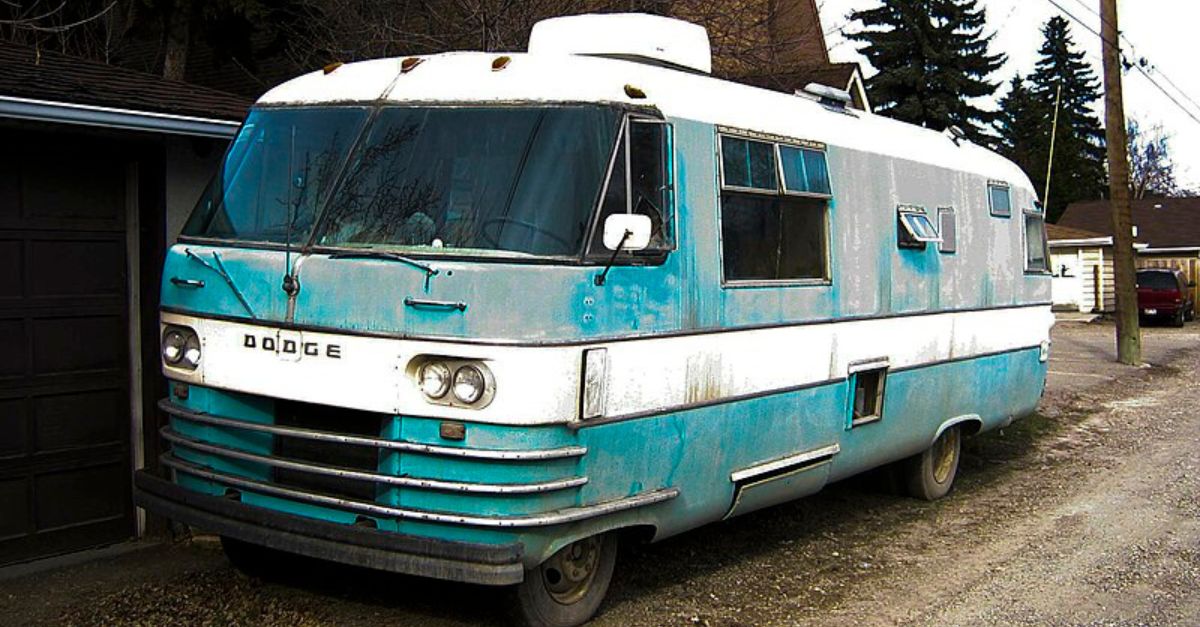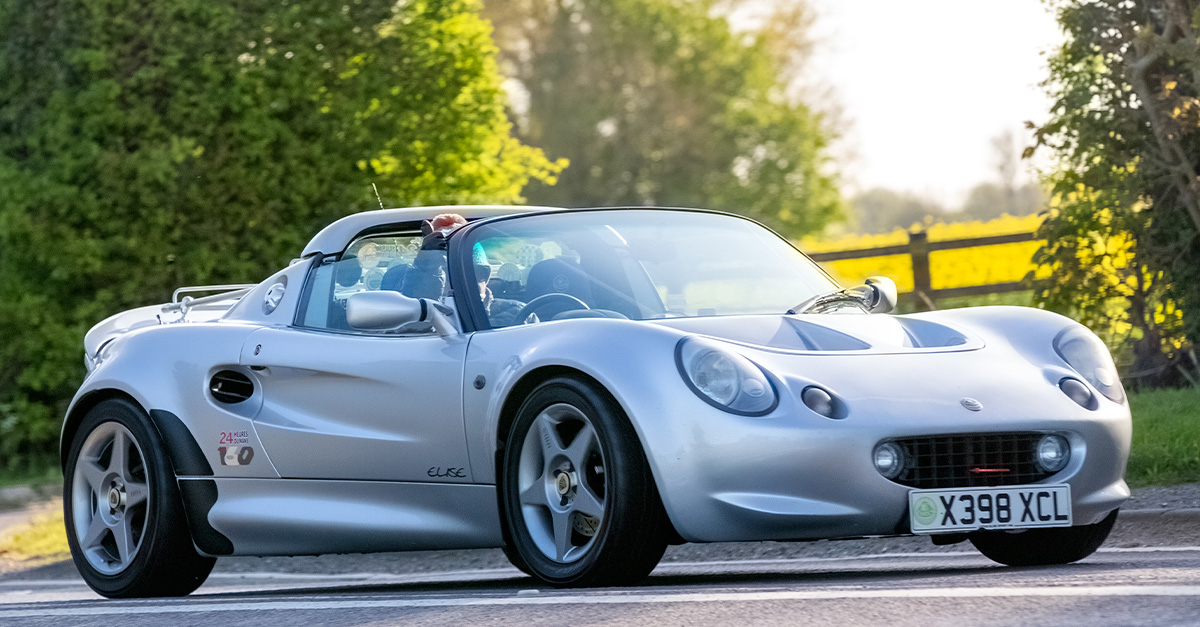Lap Of Luxury
The Ford Thunderbird started life as a two-seater convertible, and ended life a half-century later as a two-seater convertible. In between, there were different seats and different styles, but the “T-Bird” shaped what generations of drivers thought a “personal luxury car” should be.
Contest Time
American carmakers liked what they saw in European sports cars, but were having trouble coming up with a homegrown solution. So, Henry Ford II and Motor Trend magazine announced a contest for such a design in 1950, with rules requiring the use of a Ford Anglia chassis.
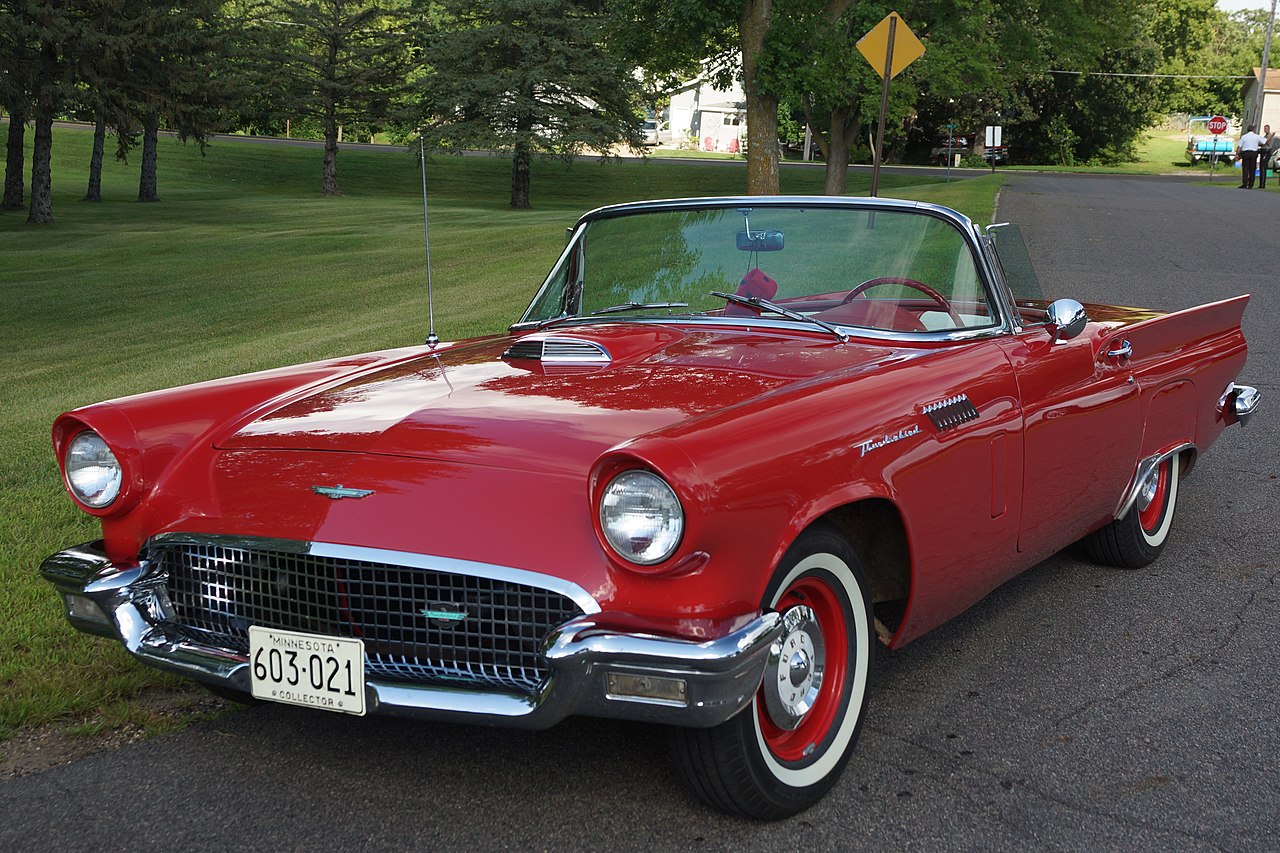 Greg Gjerdingen, CC BY 2.0, Wikimedia Commons
Greg Gjerdingen, CC BY 2.0, Wikimedia Commons
The One And Only
The winner was a designer and clay modelist named Vince E Gardner, whose initials (and a second letter) spelled out “Vega”. Ford went so far as to commission a prototype—not to be confused with the ill-fated Chevrolet Vega of the 1970s—but events had overtaken the idea.
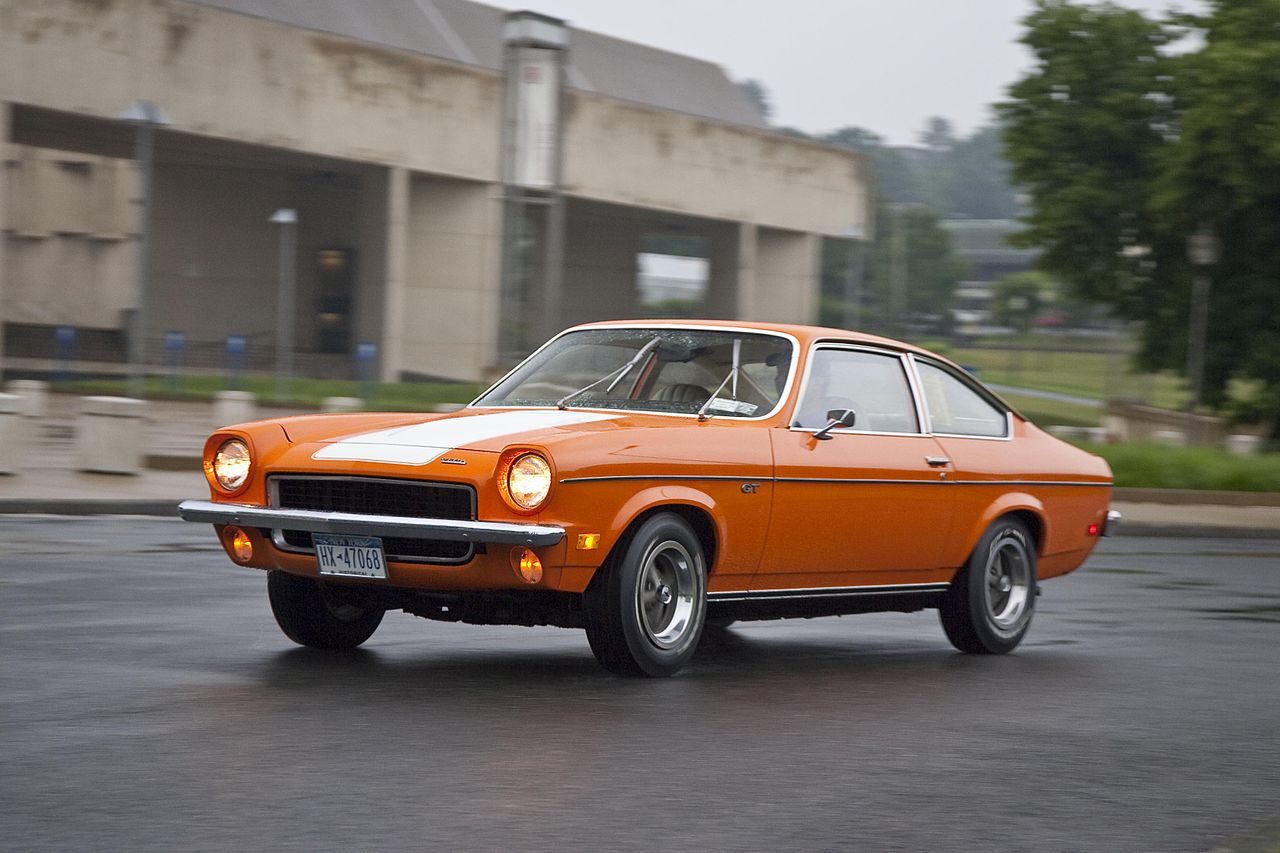 Barnstarbob, CC BY-SA 3.0, Wikimedia Commons
Barnstarbob, CC BY-SA 3.0, Wikimedia Commons
Presenting The Corvette
With great fanfare, Chevrolet had unveiled its Corvette in January 1953. It would turn out to be “the most popular sports car in history,” as one writer put it, and Ford decided to push the pedal to the metal to get its own offering out there as quickly as possible. And the Vega wasn’t it.
 Mustang Joe, Wikimedia Commons
Mustang Joe, Wikimedia Commons
This And That
Ford had decided the Vega was too costly to make, looked too European, and wouldn’t have enough power under the hood. Instead, Ford wanted a sports car lite, something sporty but with more creature comforts and a strong hint of luxury. Racing performance was not mandatory.
 Pat Durkin, CC BY-SA 2.0, Wikimedia Commons
Pat Durkin, CC BY-SA 2.0, Wikimedia Commons
Ready To Go
The new car was developed at lightning speed, with a prototype unveiled in February 1954, about a year after development had started. Ford assembly lines ramped up, and the Thunderbird was ready for the public by the autumn start of the 1955 model year.
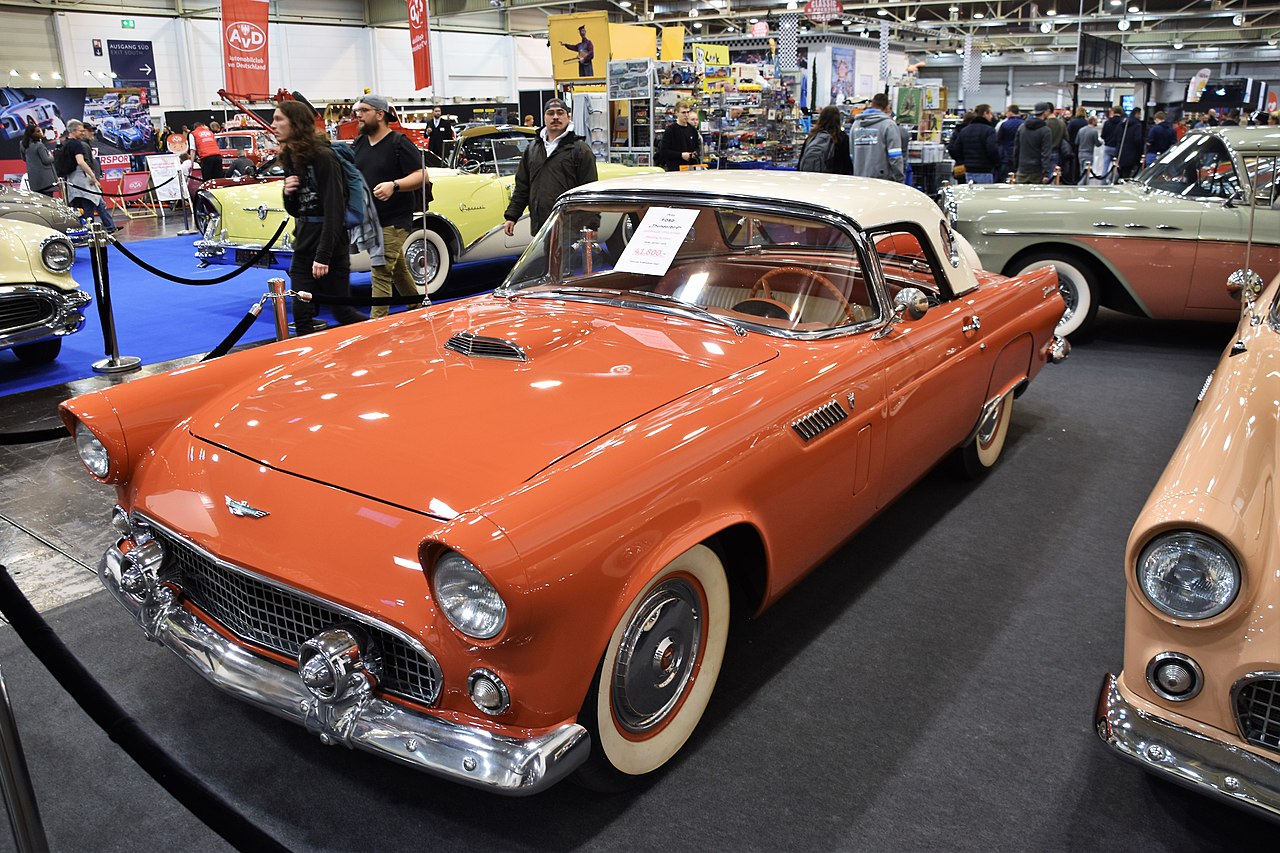 Charles, CC BY 2.0, Wikimedia Commons
Charles, CC BY 2.0, Wikimedia Commons
The Sporty Non-Sports Car
The inaugural 1955 model was a two-seat convertible, meant to look sporty, but it didn’t have to be a player in the same market as a Chevrolet Corvette, a model that had no trouble letting the world know it was a sports car. However, straddling the fence would work well for the new car.
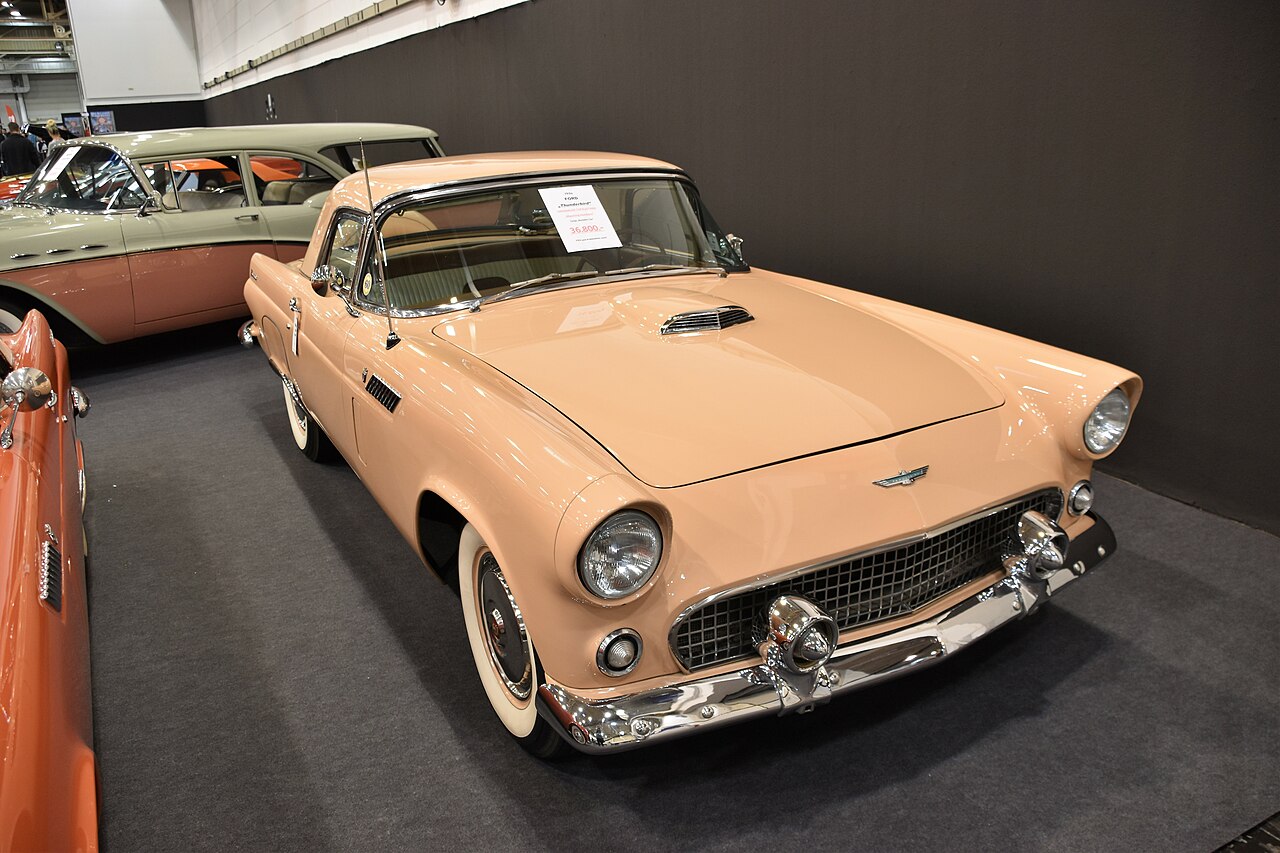 Charles, CC BY 2.0, Wikimedia Commons
Charles, CC BY 2.0, Wikimedia Commons
Racing For Dollars
Ford was trying to have it both ways. The company initially did use the phrase “sports car,” and the Thunderbird, for the first few years, had a crossed-flag emblem on its hood, suggesting it was ready to race. And Ford would win one race for sure: the race for sales.
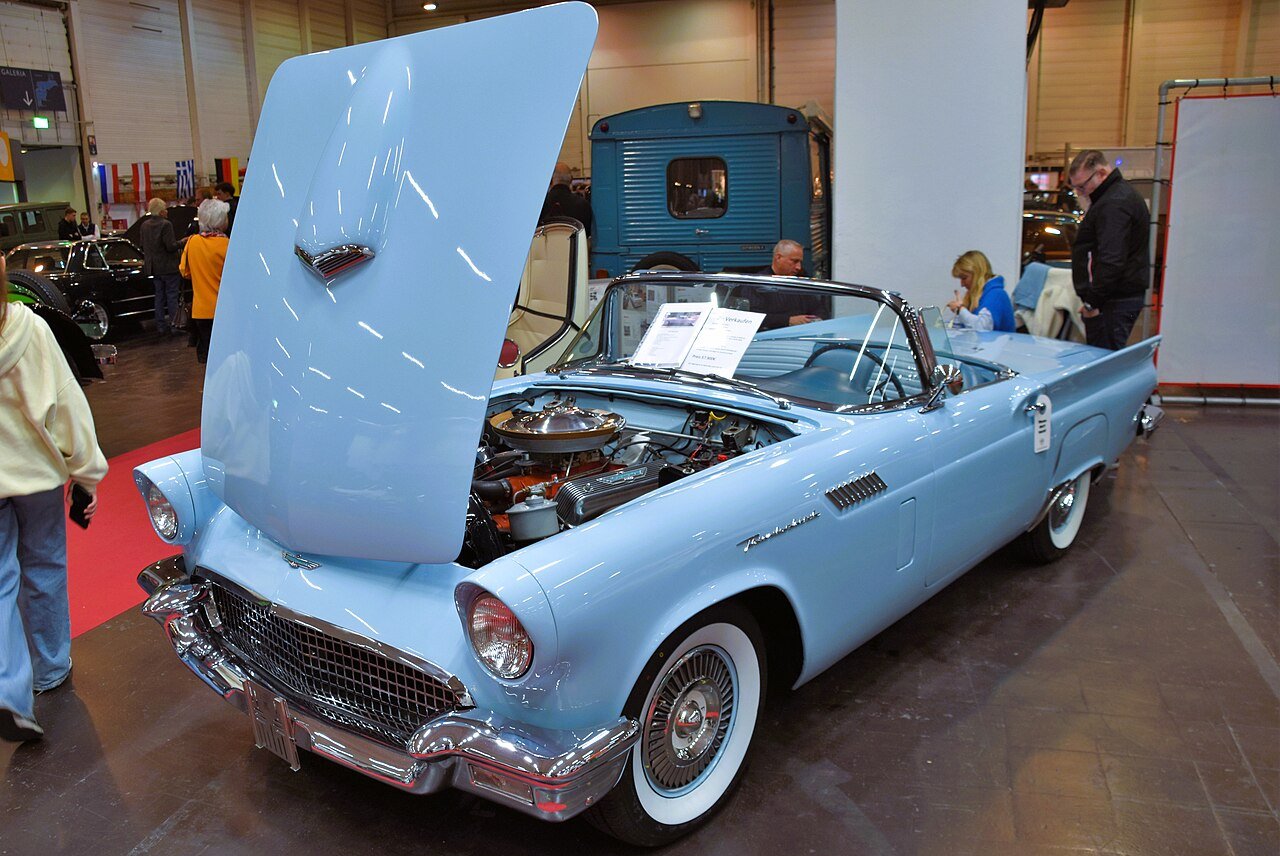 Charles, CC BY 2.0, Wikimedia Commons
Charles, CC BY 2.0, Wikimedia Commons
In The Passing Lane
The inaugural 1955 Thunderbird saw sales of 16,000 units fly far past the Corvette’s 700. Ford’s “personal car of distinction” was staking out its own turf, and it worked. With its hood scoop and a speedometer reaching 150 mph (240 km/h), it had sports car vibes—but fewer drawbacks.
 Charles, CC BY 2.0, Wikimedia Commons
Charles, CC BY 2.0, Wikimedia Commons
Comfort Zone
Since driver comfort was a higher priority than racing performance, the Thunderbird could appeal to a wider market—and that market responded spectacularly. Not only did the Thunderbird’s sales exceed Corvette’s that first year, it exceeded Ford’s own projections of 10,000.
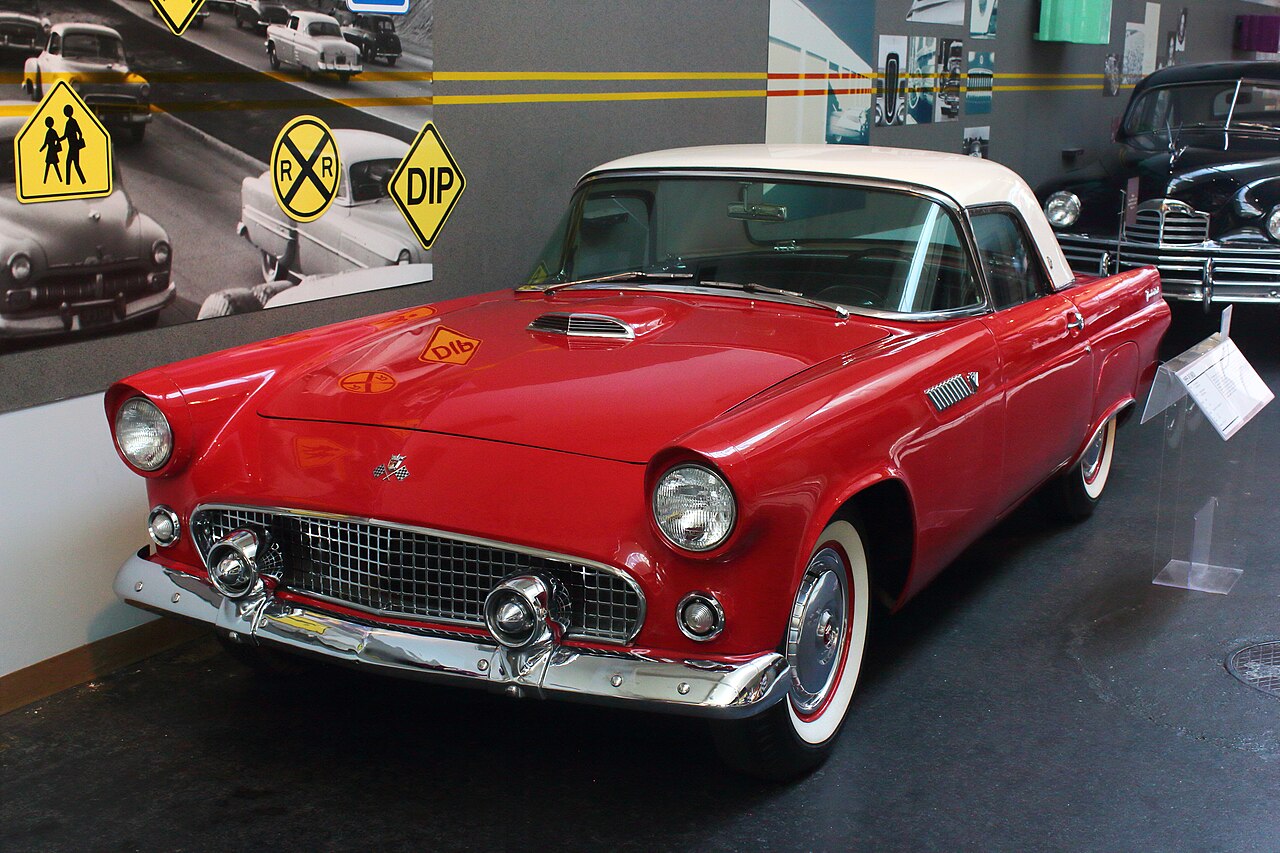 Andromeda2064, CC BY-SA 4.0, Wikimedia Commons
Andromeda2064, CC BY-SA 4.0, Wikimedia Commons
Rank Confusion
And as the number-two automaker, Ford targeted top dog GM by selling this higher-priced model at ordinary Ford dealerships, helping to undermine all of Detroit’s pecking order of brands. But GM had developed this stratification the most, so stood to lose the most from Ford’s brashness.
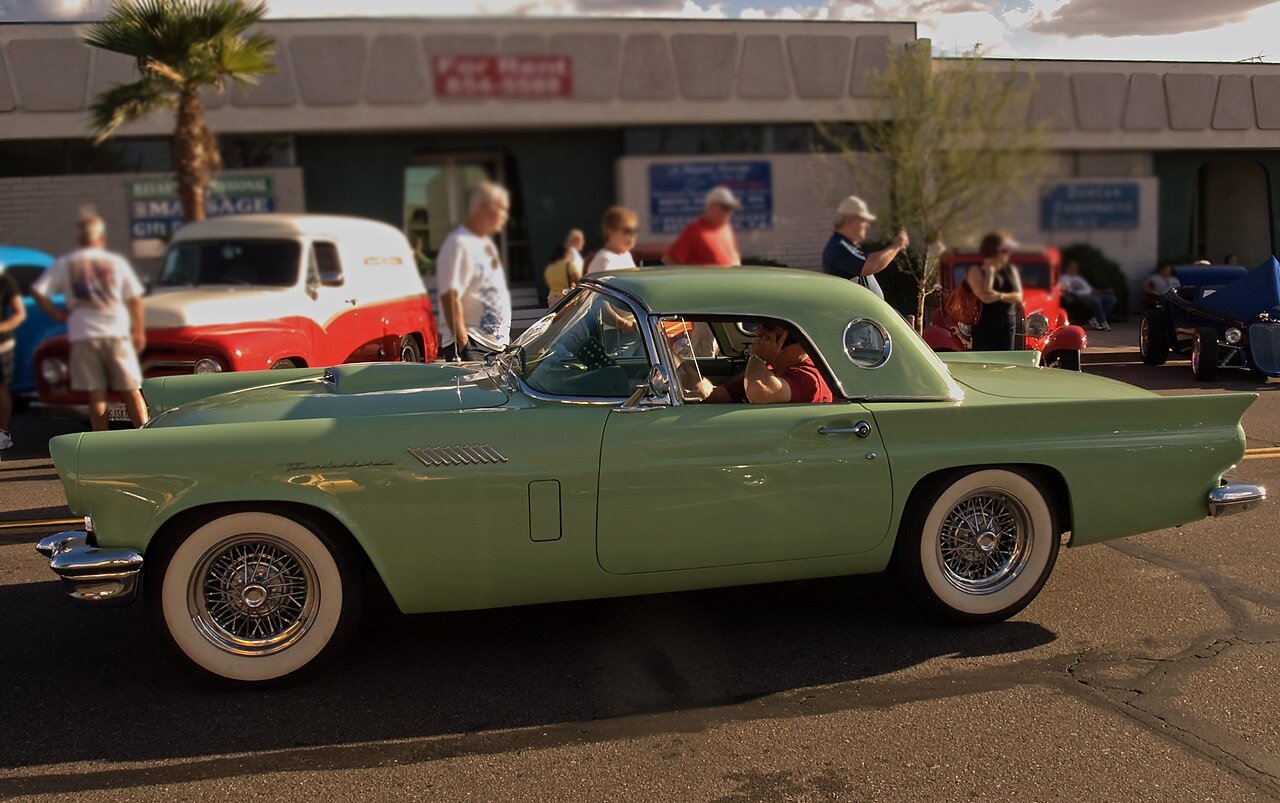 Dorian Wallende, CC BY-SA 2.0, Wikimedia Commons
Dorian Wallende, CC BY-SA 2.0, Wikimedia Commons
Seat Of The Problem
With success like that right out of the gate, Ford mostly stuck to the formula for a few years. But execs worried they were crimping sales by sticking to a two-seater. Maybe it was time to shake things up—or maybe it was time to just ditch the Thunderbird.
 Abxbay, CC BY-SA 4.0, Wikimedia Commons
Abxbay, CC BY-SA 4.0, Wikimedia Commons
Loss Leader
Even though Thunderbird sales had been spectacular, the car wasn’t producing big profits. General manager Lewis Crusoe reportedly had seen the sporty Thunderbird as a promotional venture, a way to attract customers to Ford, rather than to build up that one model in particular.
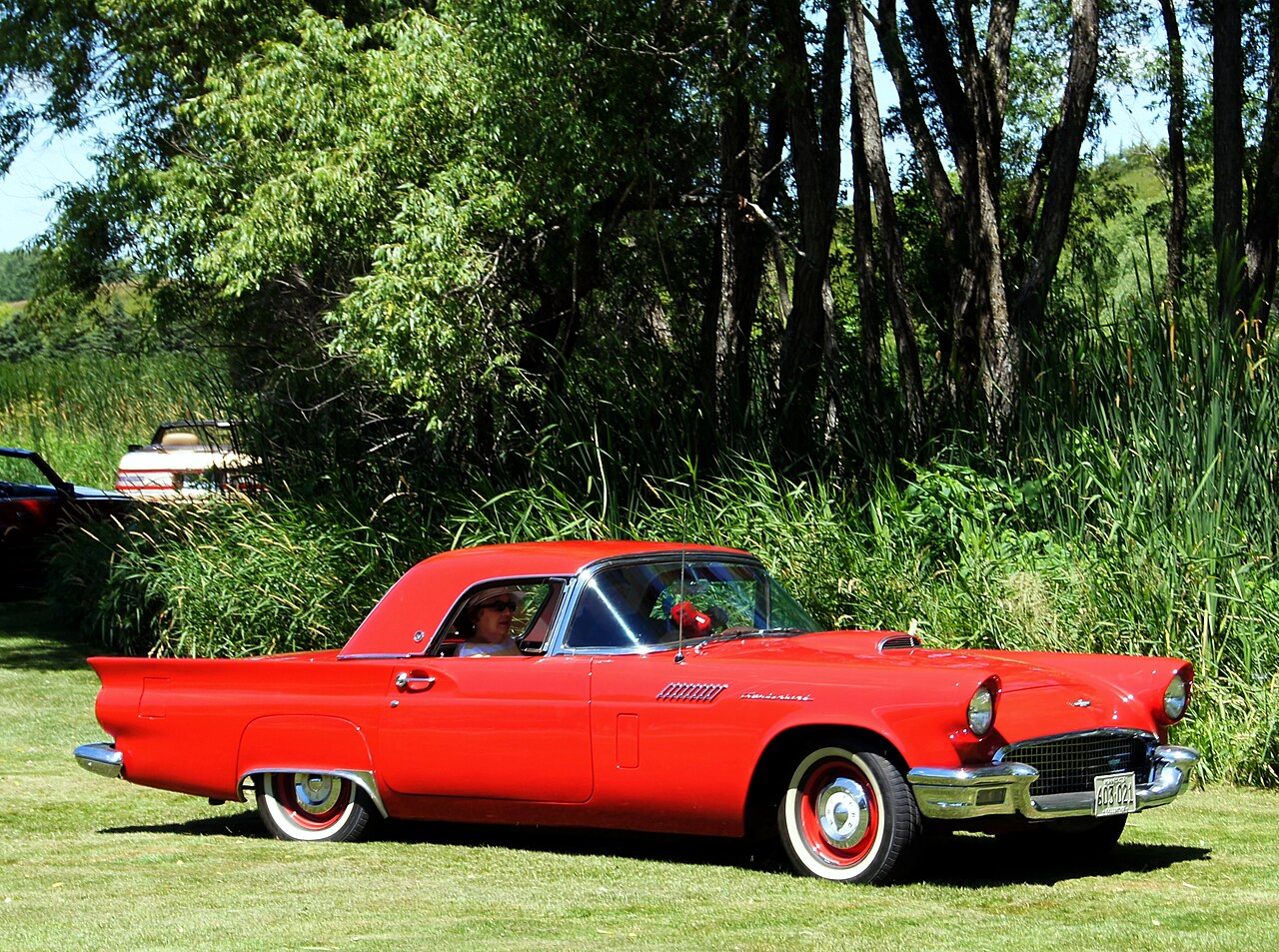 Greg Gjerdingen, CC BY 2.0, Wikimedia Commons
Greg Gjerdingen, CC BY 2.0, Wikimedia Commons
In The Balance
Plus, a new general manager, Robert McNamara, didn’t particularly like sports cars, and certainly not an unprofitable one. A two-seater was a niche market, great for customers who could afford a second car. But attract more customers and the Thunderbird might have a future.
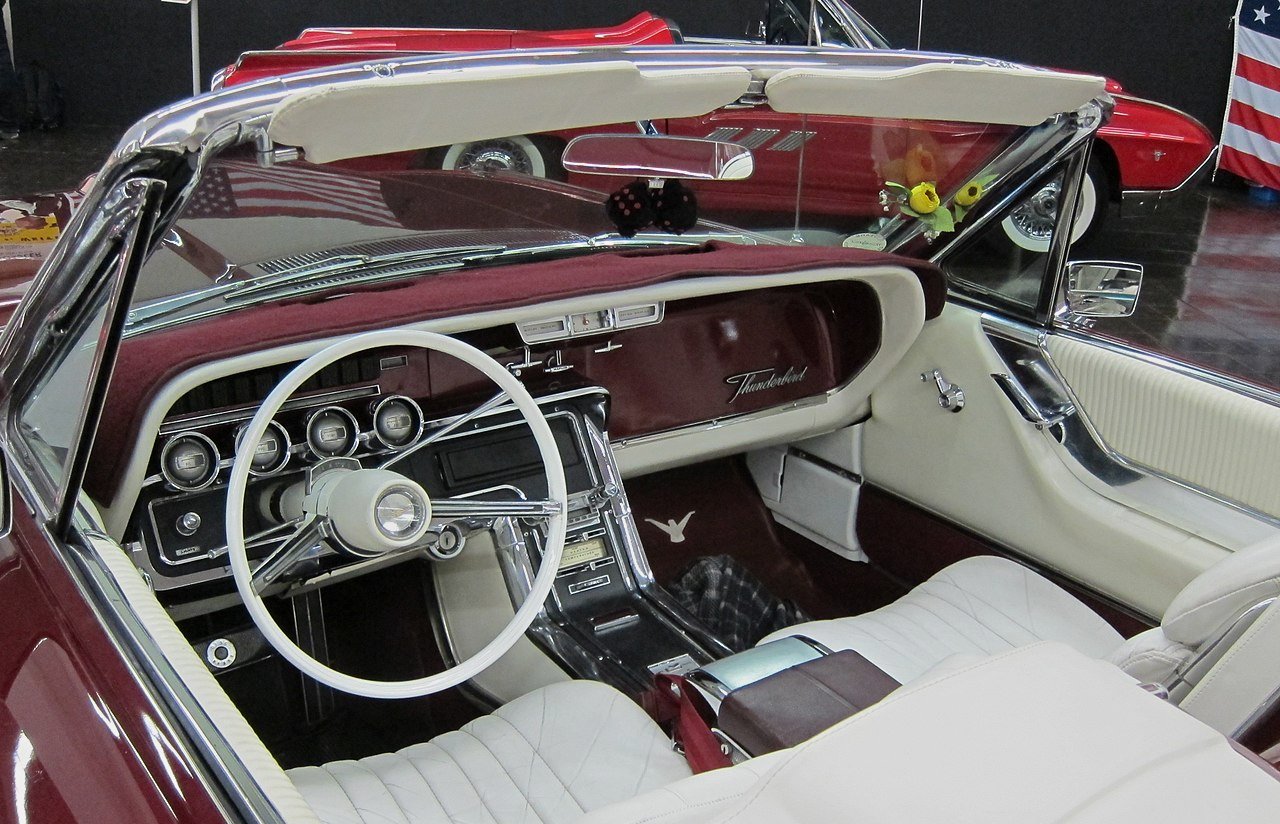 Triple-green, CC BY-SA 2.0, Wikimedia Commons
Triple-green, CC BY-SA 2.0, Wikimedia Commons
Two Times Two
Appropriately enough, the Thunderbird Golf Club in Palm Springs, California was where the big news was revealed. As 1957 turned into 1958, New Year’s revelers learned that Ford’s sporty two-seater was turning into a four-seater. The Thunderbird would not be grounded after all.
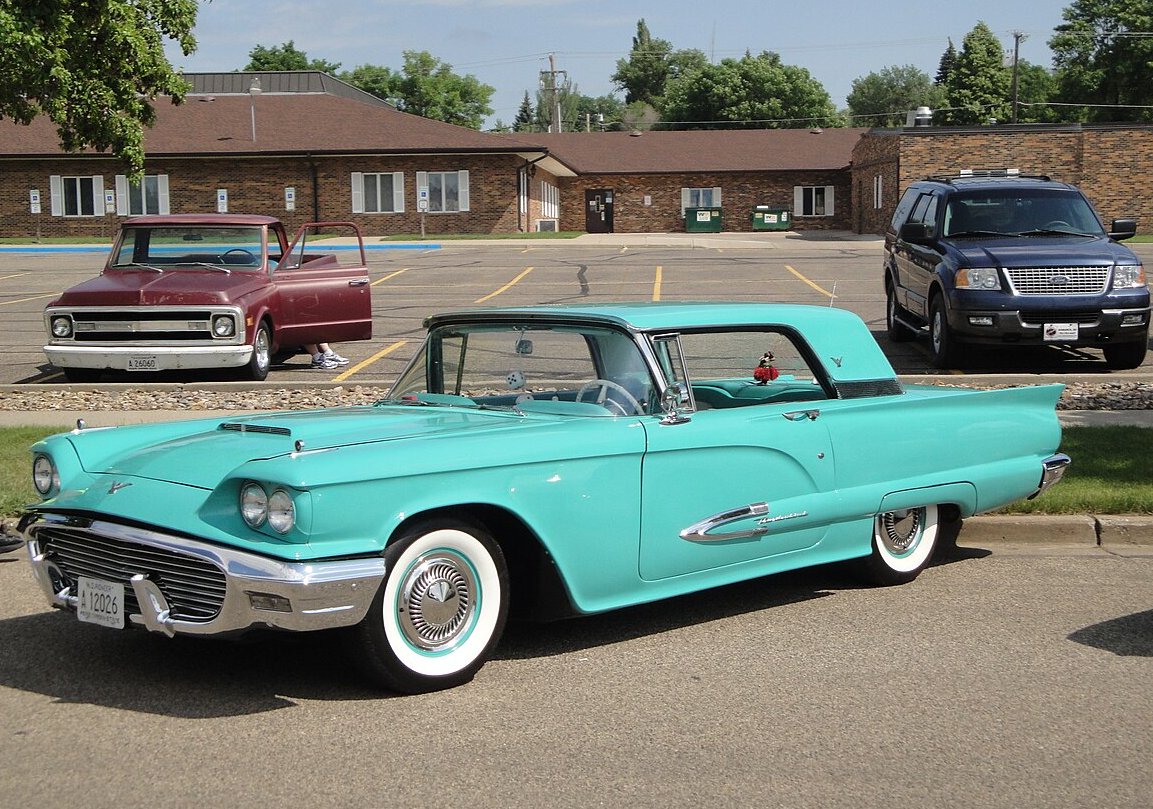 Greg Gjerdingen, CC BY 2.0, Wikimedia Commons
Greg Gjerdingen, CC BY 2.0, Wikimedia Commons
Impressive Numbers
Dealers got a hold of the hardtop in early 1958, and the convertible a few months later. Customers were eager and willing, snapping up the mid-season release. In the next three years, sales would quadruple the total from the two-seater era. And another trend was in the making.
 sv1ambo, CC BY 2.0, Wikimedia Commons
sv1ambo, CC BY 2.0, Wikimedia Commons
Big Trend
Over the next two decades, Ford would design bigger and bigger Thunderbirds, before downscaling hit in 1977. For the 1958 model, engineers stretched the wheelbase to 113.0 inches (2,870 mm) for that back seat, and the car got heavier by 800 lbs (363 kg).
Sales Power
The basic engine was a 5.8-liter FE V8, its 300 horsepower a big jump over the standard 245 horsepower the previous year. Other features got bigger too, such as tailfins and the hood scoop. And there was a big jump in sales over 1957, more than doubling to 38,000. But there was more to come.
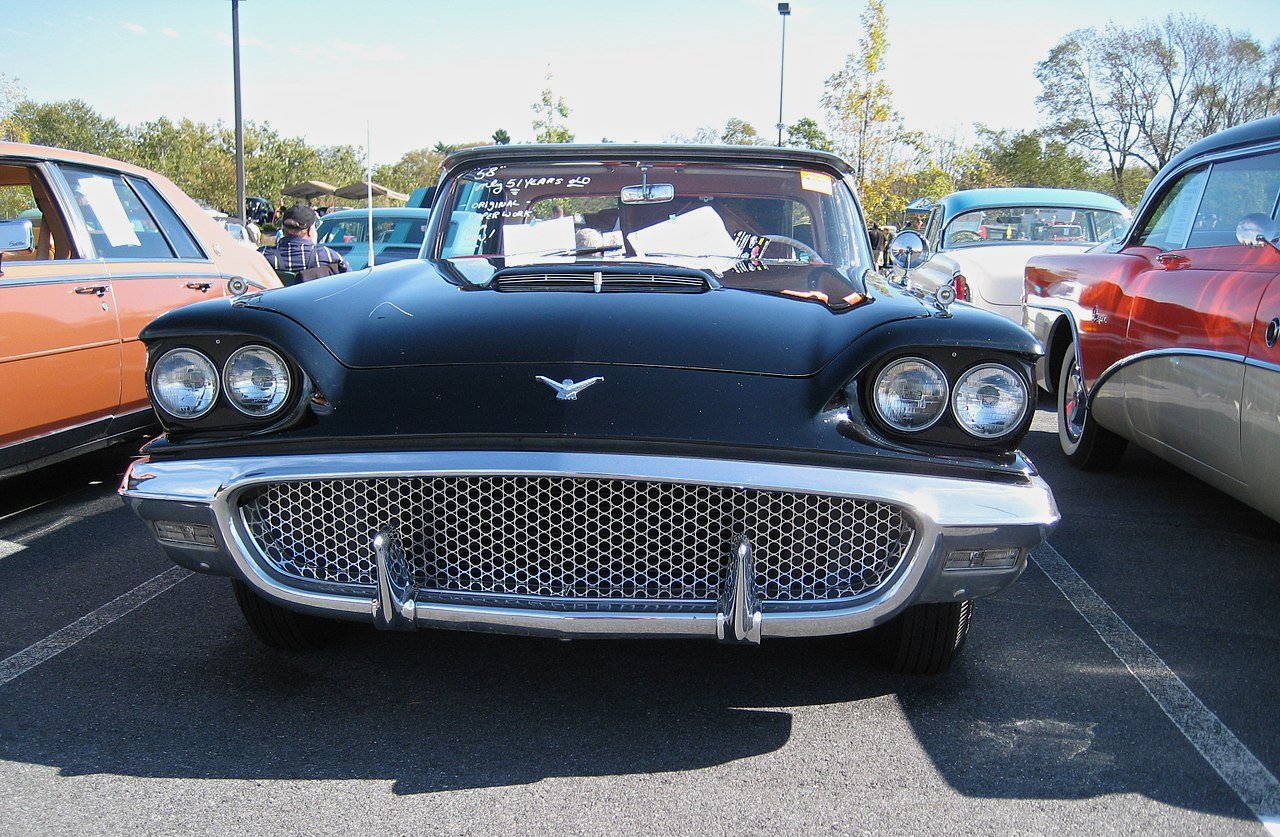 JOHN LLOYD, CC BY 2.0,Wikimedia Commons
JOHN LLOYD, CC BY 2.0,Wikimedia Commons
Uphill Movement
The 1959 Thunderbird offered a new option of a 350 hp 7.0-liter V8 engine, and a fancy new grille. Sales surpassed 67,000 that year. And in 1960, hardtops got a sunroof option, though you had to hand-crank it. Sales sped up to nearly 93,000. But soon a new generation beckoned.
 Bene Riobó, CC BY-SA 4.0, Wikimedia Commons
Bene Riobó, CC BY-SA 4.0, Wikimedia Commons
Like A Speeding Bullet
The 1961 model unleashed a third generation, with futuristic design nicknaming it “Bullet Bird” and “Projectile Bird”. The bird came with a 300 hp 6.4-liter FE V8 and three-speed automatic transmission—and sales came in at 73,000, helped by some high-flying product placement.
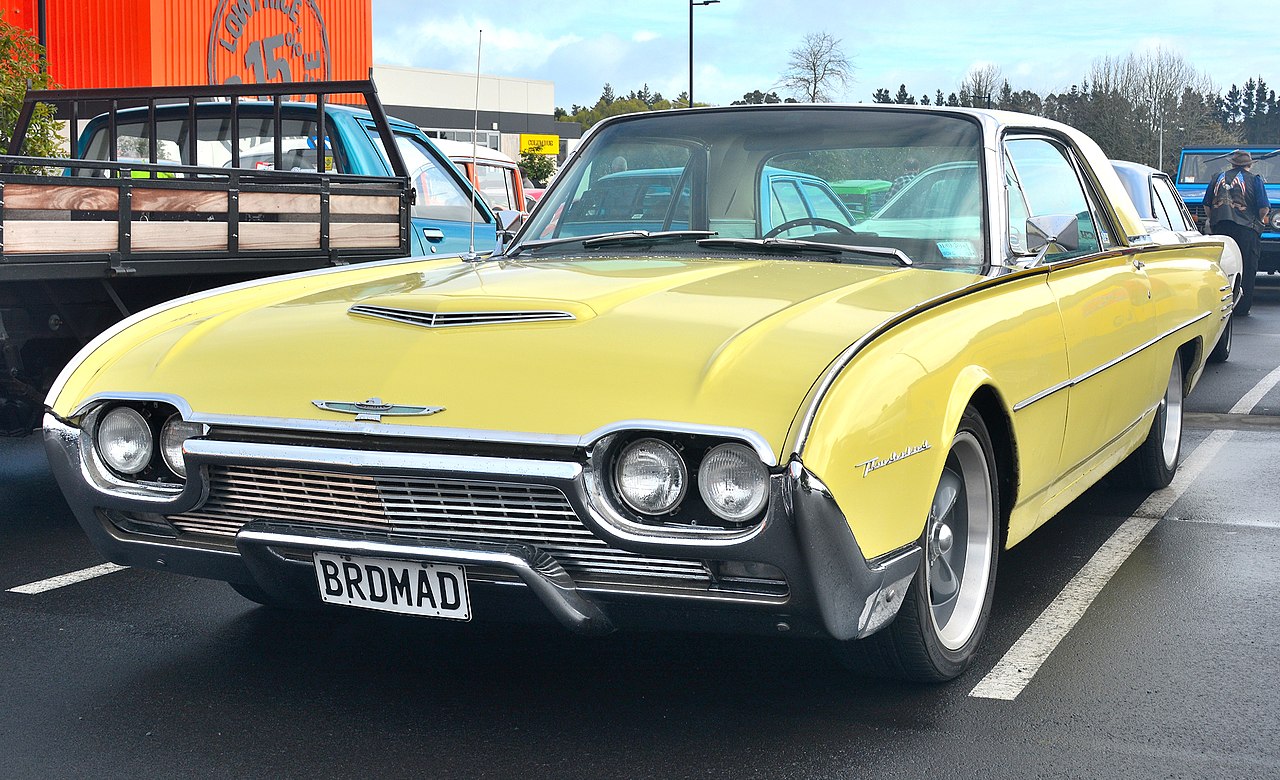 GPS 56, CC BY 2.0, Wikimedia Commons
GPS 56, CC BY 2.0, Wikimedia Commons
A Ford Presentation
The 1961 Thunderbird was the Indy 500 pace car, and appeared on the detective show 77 Sunset Strip. But TV viewers could also catch glimpses of the 50 white Thunderbird convertibles Ford made for John F Kennedy’s inaugural parade, each with a red-white-and-blue interior.
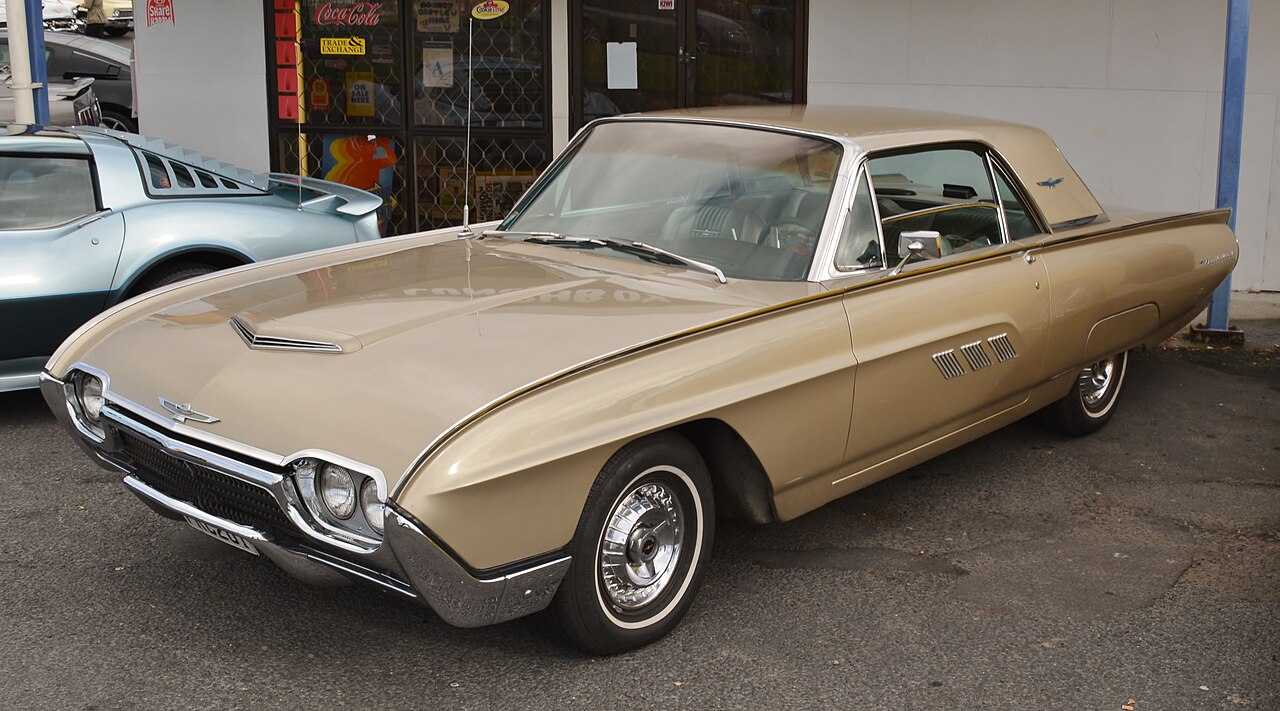 GPS 56, CC BY 2.0, Wikimedia Commons
GPS 56, CC BY 2.0, Wikimedia Commons
A Sophisticated Drive
And there were moments when the Thunderbird seemed to be America itself. It had power, with impressive engines getting into 300 hp territory. Leather seats and power windows exuded an air of classy sophistication. And sales smashed predictions throughout those early years.
 Spanish Coches, CC BY 2.0, Wikimedia Commons
Spanish Coches, CC BY 2.0, Wikimedia Commons
A Bit More Square
The Thunderbird’s fourth generation started off with the 1964 model year. Customers could still choose between hardtop or convertible—or spring for a landau version, first made available two years previous. The look was a bit less futuristic, with squarish bends returning to the fold.
 Bene Riobó, CC BY-SA 4.0, Wikimedia Commons
Bene Riobó, CC BY-SA 4.0, Wikimedia Commons
Hardtop On Top
Turn signals went sequential for 1965, and front disc brakes became standard. The next year, the grille imitated an egg crate, and the engine was boosted to 315 horsepower, with a 345-hp 7.0-litre FE V8 as an option. The Thunderbird convertible, meanwhile, gave its bows as an era ended.
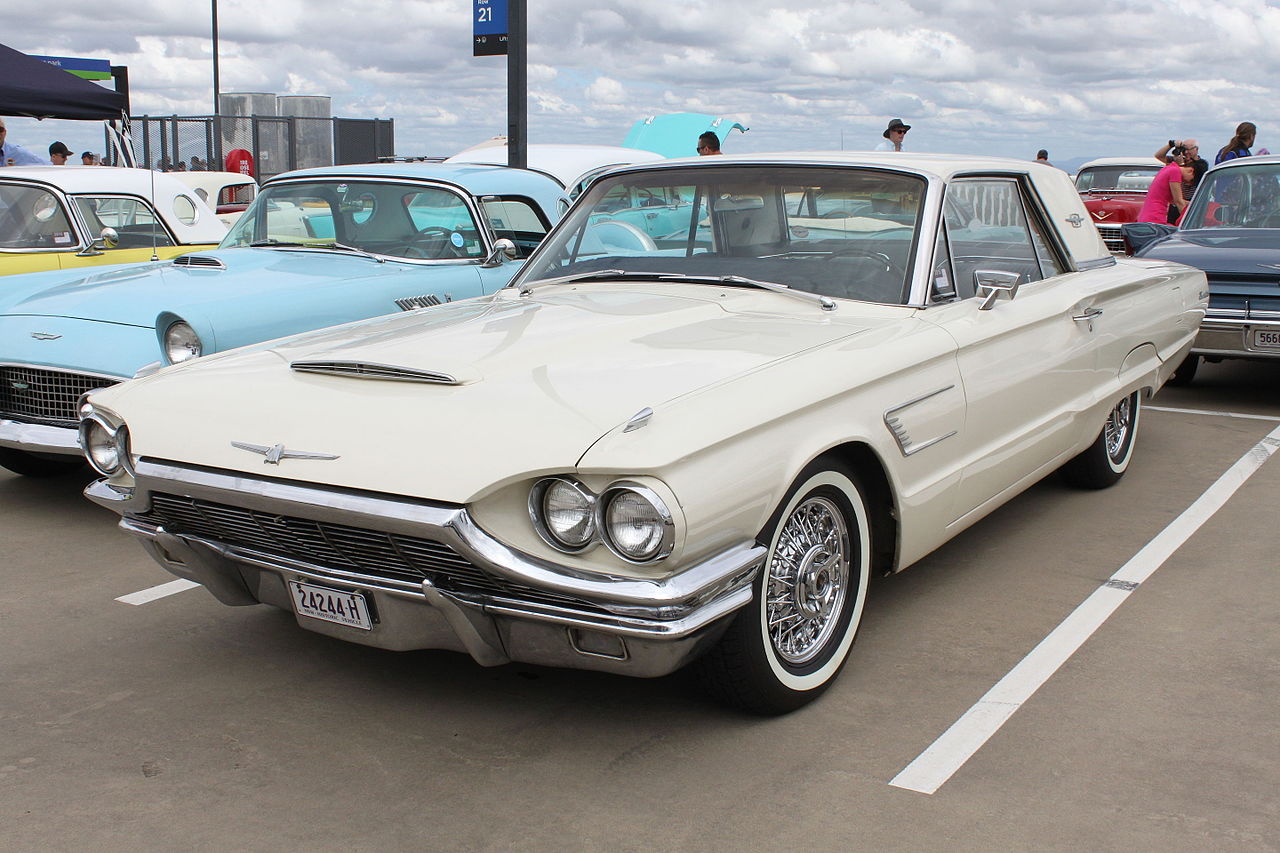 Jeremy, CC BY 2.0,Wikimedia Commons
Jeremy, CC BY 2.0,Wikimedia Commons
Outflanking The Ponies
It was 1967 and a fifth generation was unveiled. Even though the Thunderbird had gone the four-seater route in 1958, it had stuck to the two-door look. A four-door option was added in 1967 as the T-Bird got even bigger, in part to outsize pony cars that were becoming ever fancier.
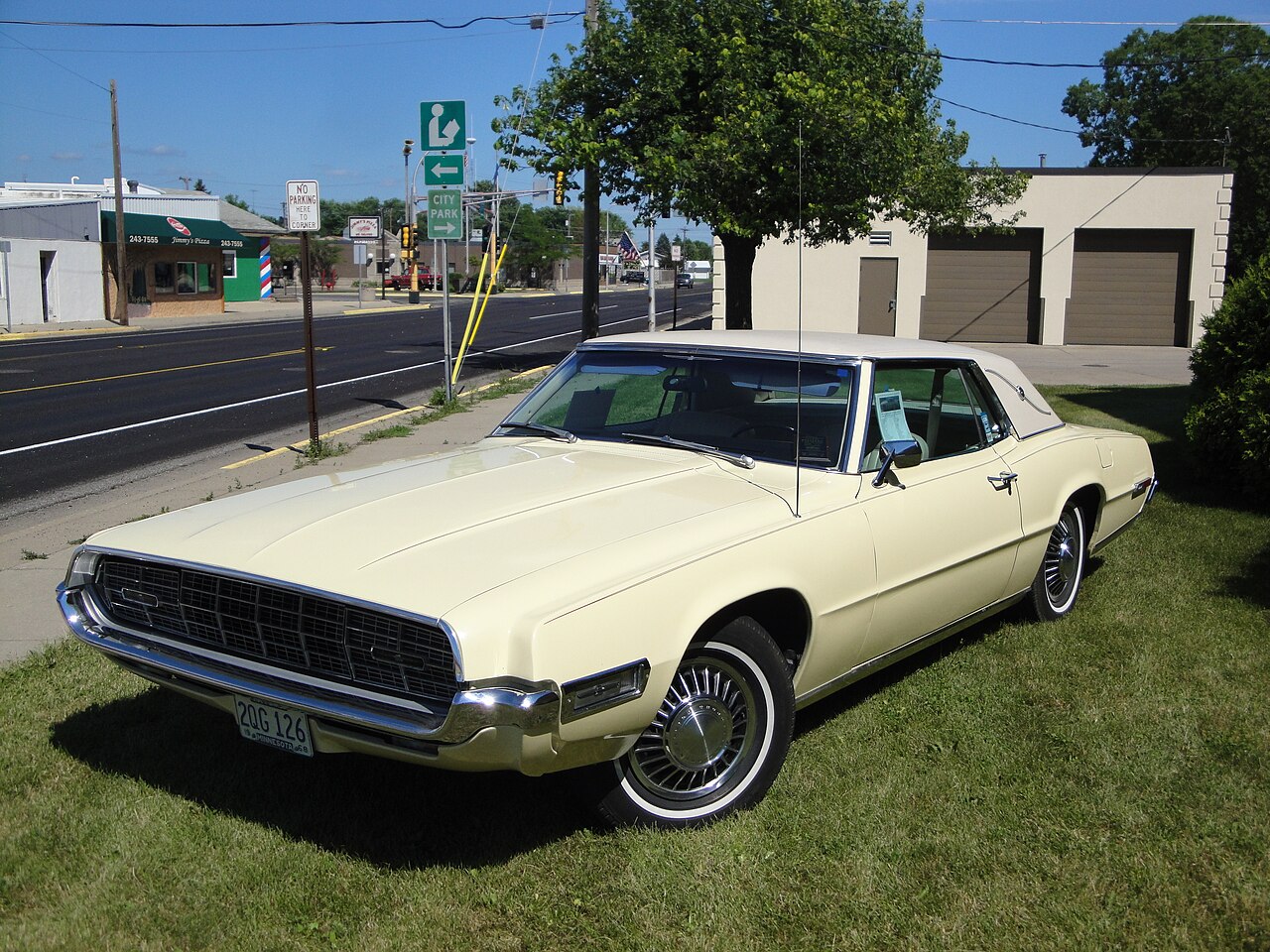 Greg Gjerdingen, CC BY 2.0, Wikimedia Commons
Greg Gjerdingen, CC BY 2.0, Wikimedia Commons
Two Of Four Doors Shut
Not a lot of dramatic changes followed. The 1970 model altered the front grille. Observers saw something jutting out of it, the leading theory being a bird’s beak. And in 1971, the four-door option made its final appearance, though not because the car was getting smaller. Anything but!
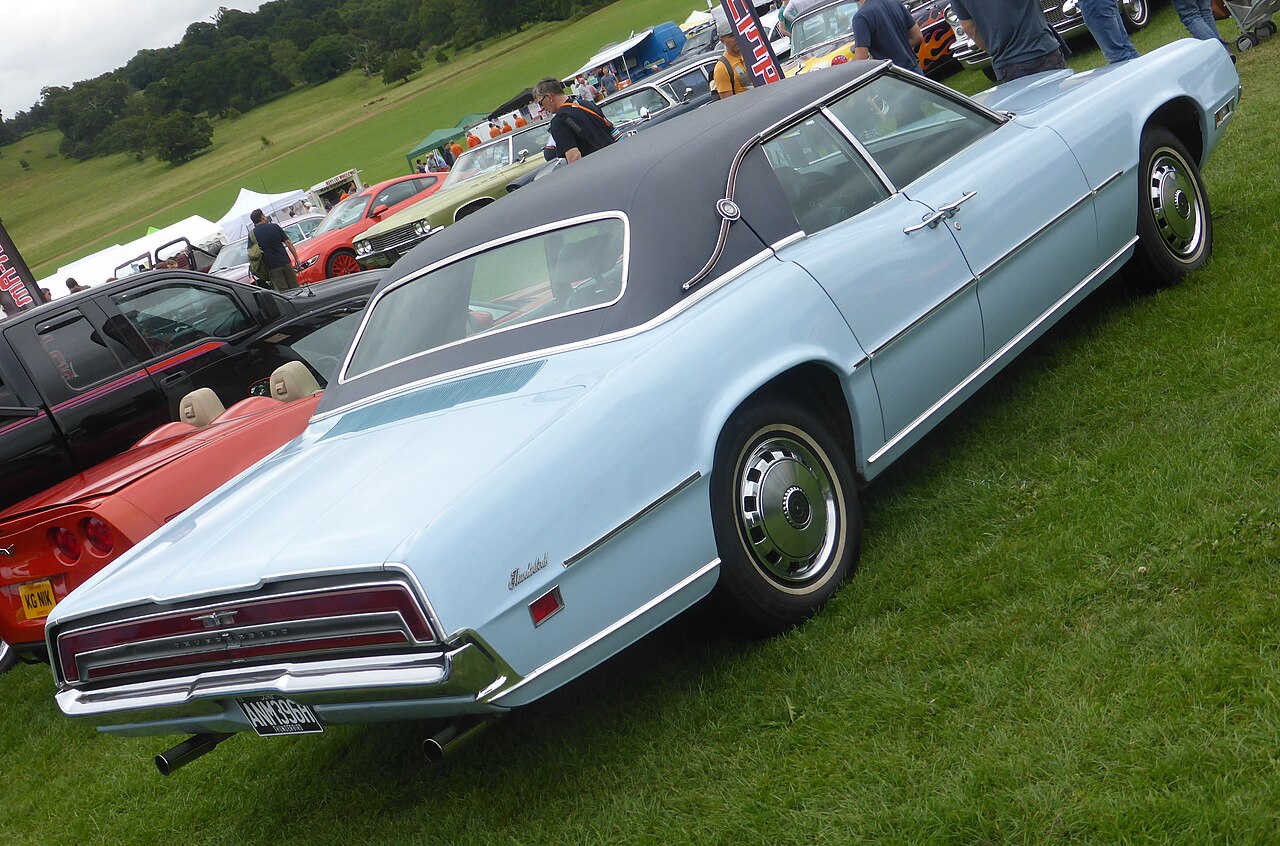 Andrew Bone, CC BY 2.0, Wikimedia Commons
Andrew Bone, CC BY 2.0, Wikimedia Commons
Big Trouble
The sixth generation started off big and strong, but trouble would ensue. The 1972 model was the largest Thunderbird produced so far, with a 120.4-inch (3,058 mm) wheelbase, a length of 214 inches (5,436 mm), and weighing 4,420 lbs (2,005 kg) or more with a bigger engine.
Heavy Trade-off
The optional 7.5-litre V8 boosted the weight to over 4,800 lbs (2,177 kg), if you didn’t settle for a 7.0-litre standard motor. But 429 cubic inches of displacement was still large, packing in lots of power. But the Thunderbird’s weight—and anti-pollution technology—stifled their potential.
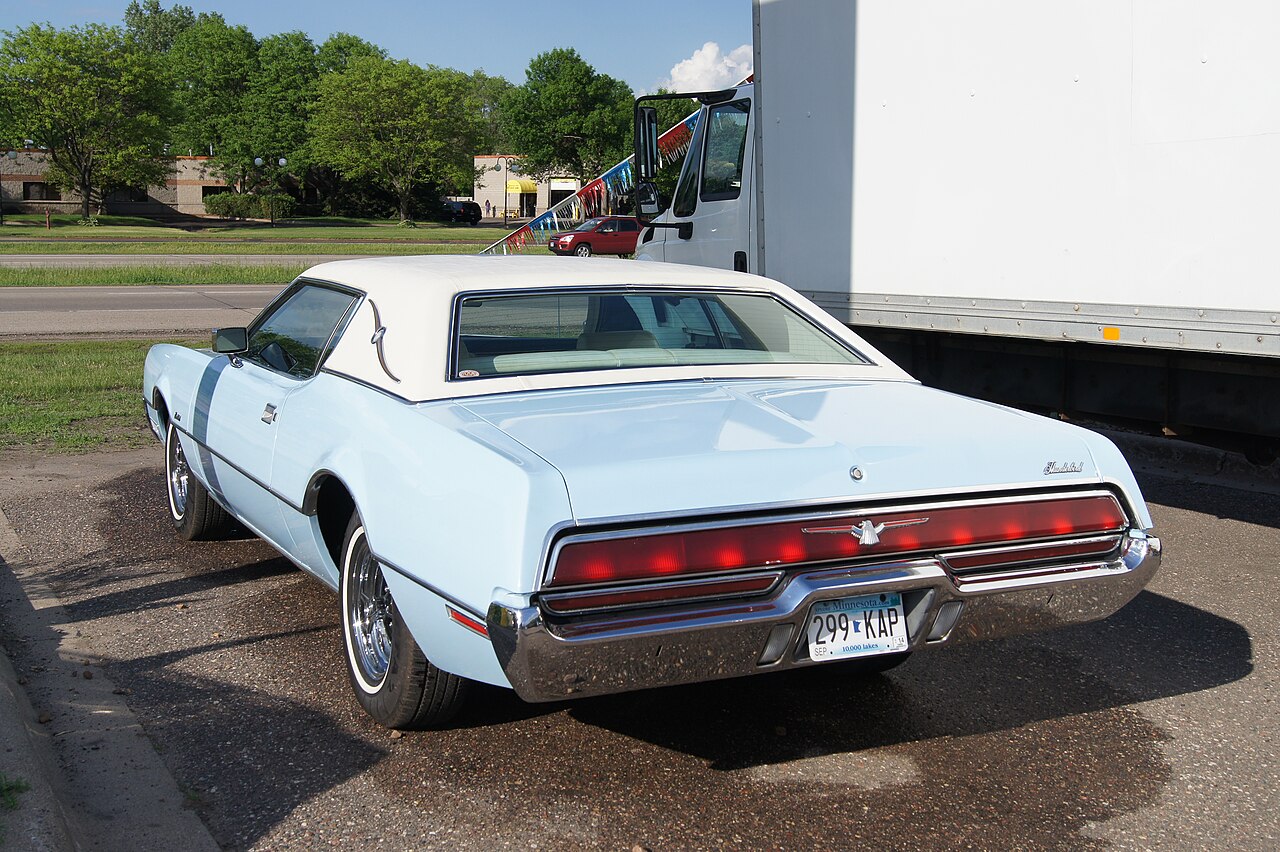 Greg Gjerdingen, CC BY 2.0, Wikimedia Commons
Greg Gjerdingen, CC BY 2.0, Wikimedia Commons
Running On Empty
Drivers weren’t going to get a lot of miles per gallon under this scenario, but many didn’t care, as Thunderbirds were snapped up even as the 1973 oil crisis hit. But eventually, rising gas prices and even stricter emissions standards cut sales so much that Ford had to rethink its plan.
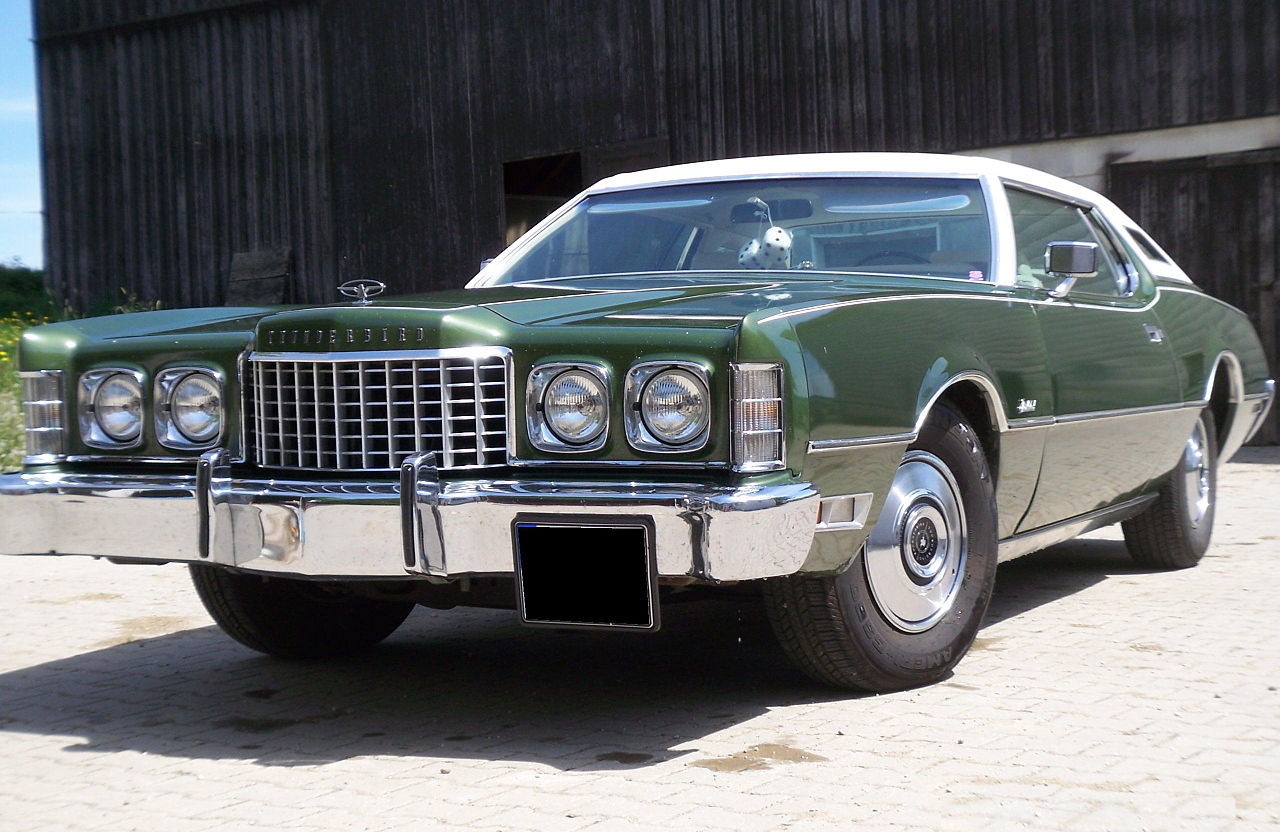 Thunderbird73, Wikimedia Commons
Thunderbird73, Wikimedia Commons
A Light Touch
For the first time, Ford downsized its Thunderbirds, launching its seventh generation with a 144-inch (2,900 mm) wheelbase, and a reduction in length of just 1.2 inches (30 mm). But the car was 900 lbs (408 kg) lighter, mostly due to a lighter drivetrain. And the T-Bird was peaking.
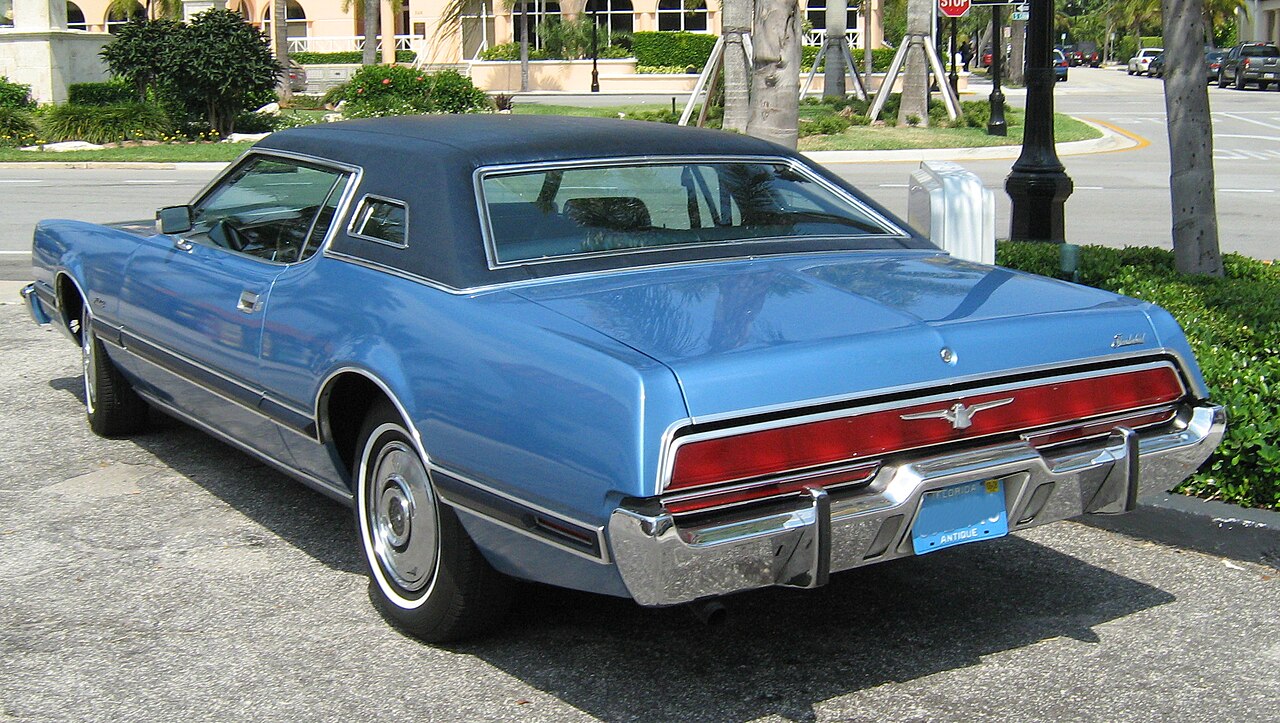 Christopher Ziemnowicz, Wikimedia Commons
Christopher Ziemnowicz, Wikimedia Commons
Not So Luxurious
Sales for the Thunderbird’s 1977 to 1979 models were strong, with customers buying a record 955,000 units over those three years. But emissions and fuel efficiency kept the push to downsize going, and the eighth generation ended any idea this was still a “personal luxury car”.
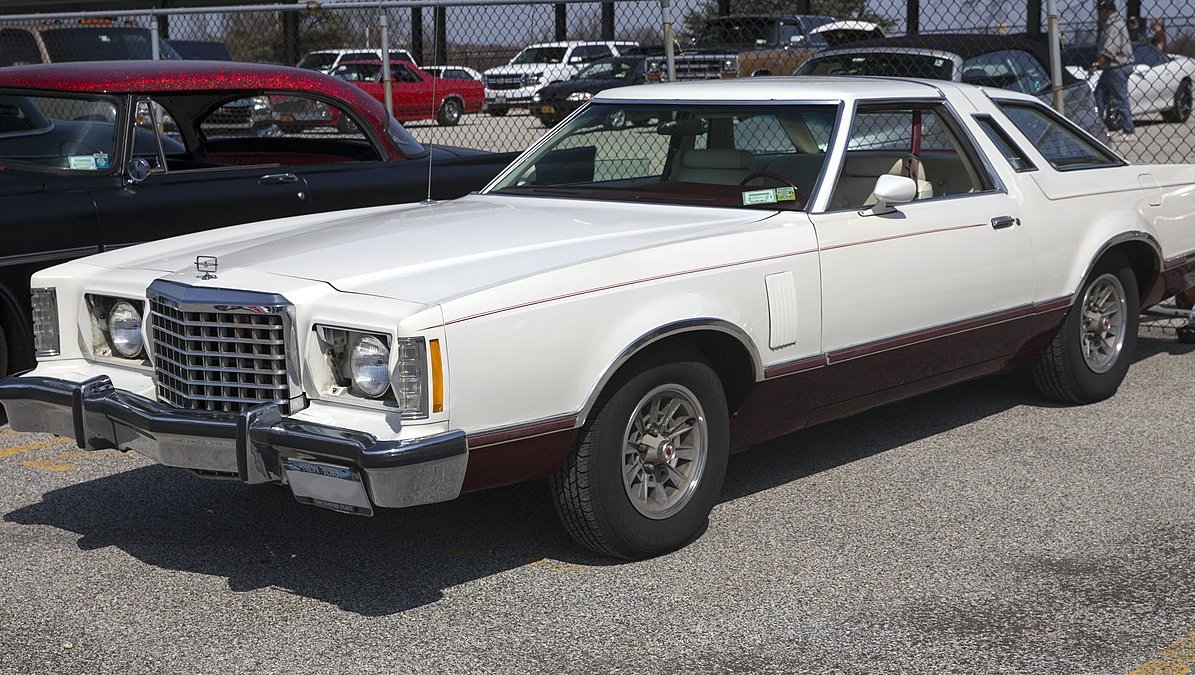 Mr.choppers, CC BY-SA 3.0, Wikimedia Commons
Mr.choppers, CC BY-SA 3.0, Wikimedia Commons
More Shrinking
The 1980 Ford Thunderbird ushered in an era of squarish design and smaller size, built on a Ford Fox platform. Some 5.6 inches (142 mm) was cut from the wheelbase, and the car shrank 17.3 inches (439 mm) in length. And the base V8 engine put out a measly 115 to 122 horsepower.
 Soernieins, CC BY-SA 3.0, Wikimedia Commons
Soernieins, CC BY-SA 3.0, Wikimedia Commons
Thrifty Choice
Then, for the first time in Thunderbird’s history, a V6 option was offered. Buyers of the 1981 model could choose the ominously named Thriftpower Six, dating back to the early 1960s. The next year, a 3.8-liter Essex V6 became standard. However, sales slumped, so it was redesign time.
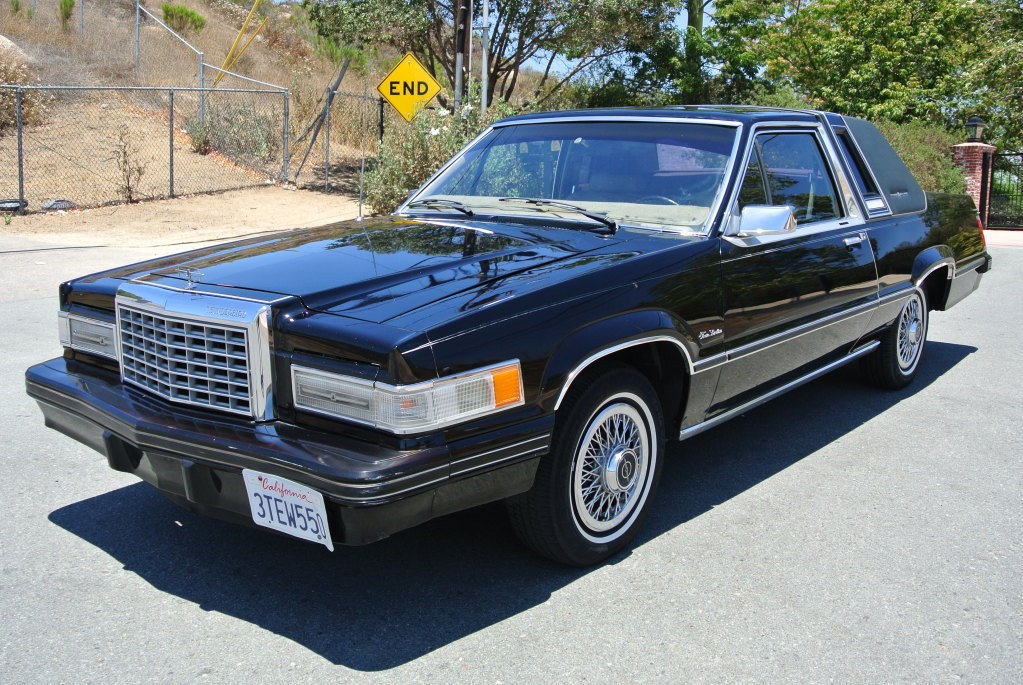 That Hartford Guy, CC BY-SA 2.0, Wikimedia Commons
That Hartford Guy, CC BY-SA 2.0, Wikimedia Commons
Learning Curve
Ford decided squarish was out and aerodynamic smoothness was in. But the 1983 Thunderbird kept that 3.8-liter Essex V6. A turbo-charged option offered 142 hp (eventually 190 hp), but Thunderbird buzz was weak by the time the ninth generation said adieu in 1988.
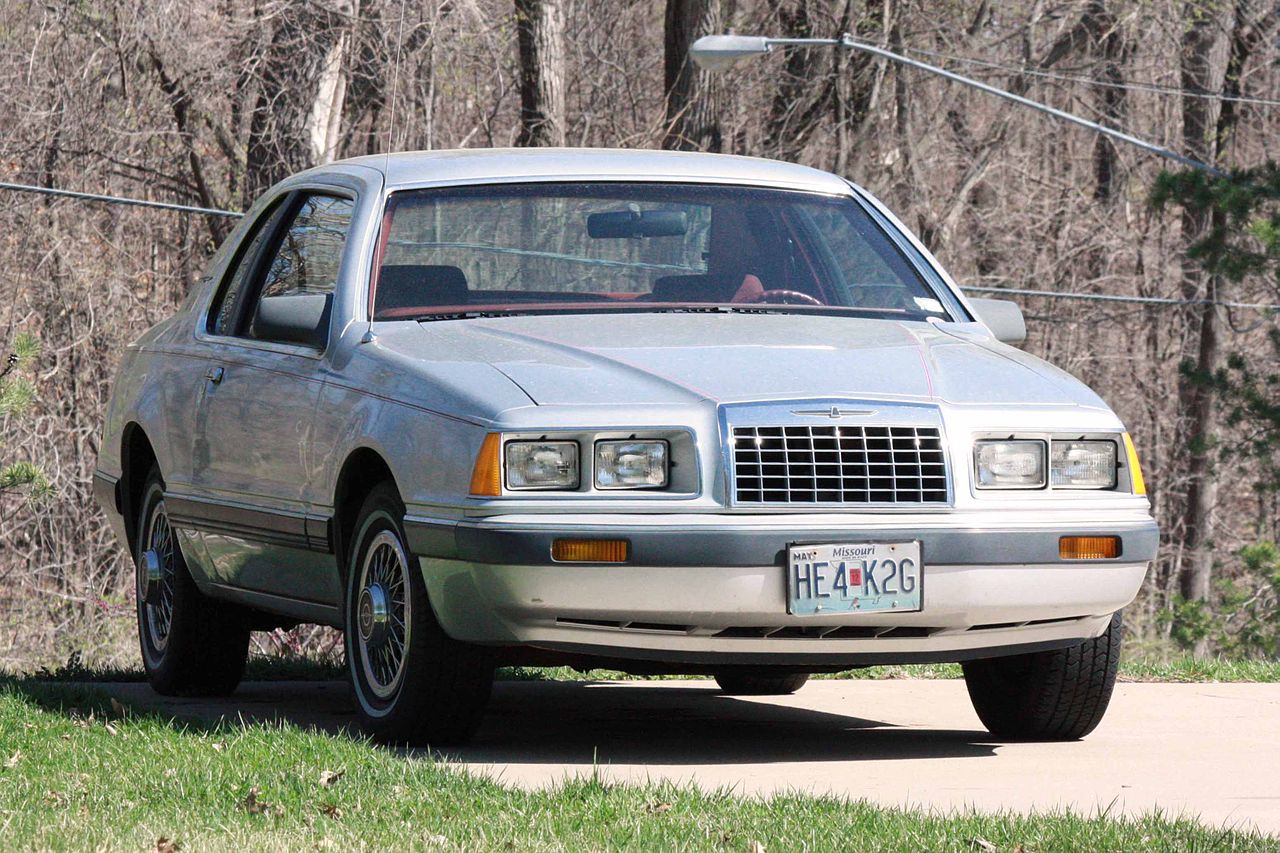 Ryanandlenny, Wikimedia Commons
Ryanandlenny, Wikimedia Commons
Smoother Riding
The tenth generation lasted from 1989 to 1997, and started with a longer wheelbase (by 9 inches or 229 mm) and a four-wheel independent suspension, so a smoother ride seemed at hand. The 3.8-liter Essex V6 was still around, though a 4.9-liter V8 became an option for 1991.
Break In The Road
There was a “Super Coupe” option that boosted the Essex to 210 hp, with more to come for the 1993 model. But the Thunderbird seemed lost, having lost its allure through various redefinitions. The end of the road approached, with the 1997 model being the T-Bird’s last—for now.
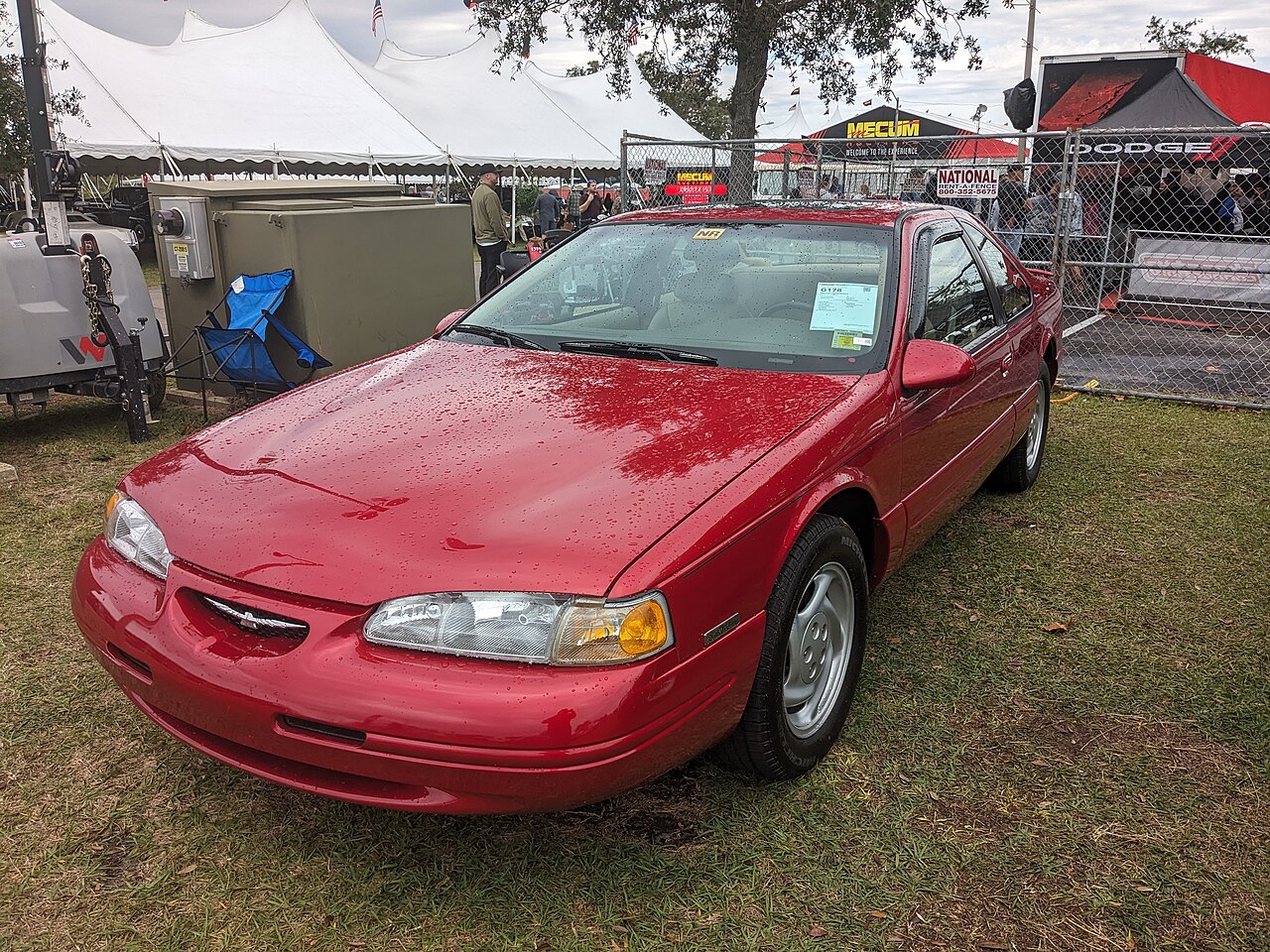 Pokemonprime, CC BY 4.0, Wikimedia Commons
Pokemonprime, CC BY 4.0, Wikimedia Commons
Back To The Past
After five years in the wilderness, the Thunderbird returned with a strong nod to nostalgia. The long-abandoned convertible option was resurrected as a new two-seater, with a strong reliance on third-generation simplicity. And there was some power behind the promise of the past.
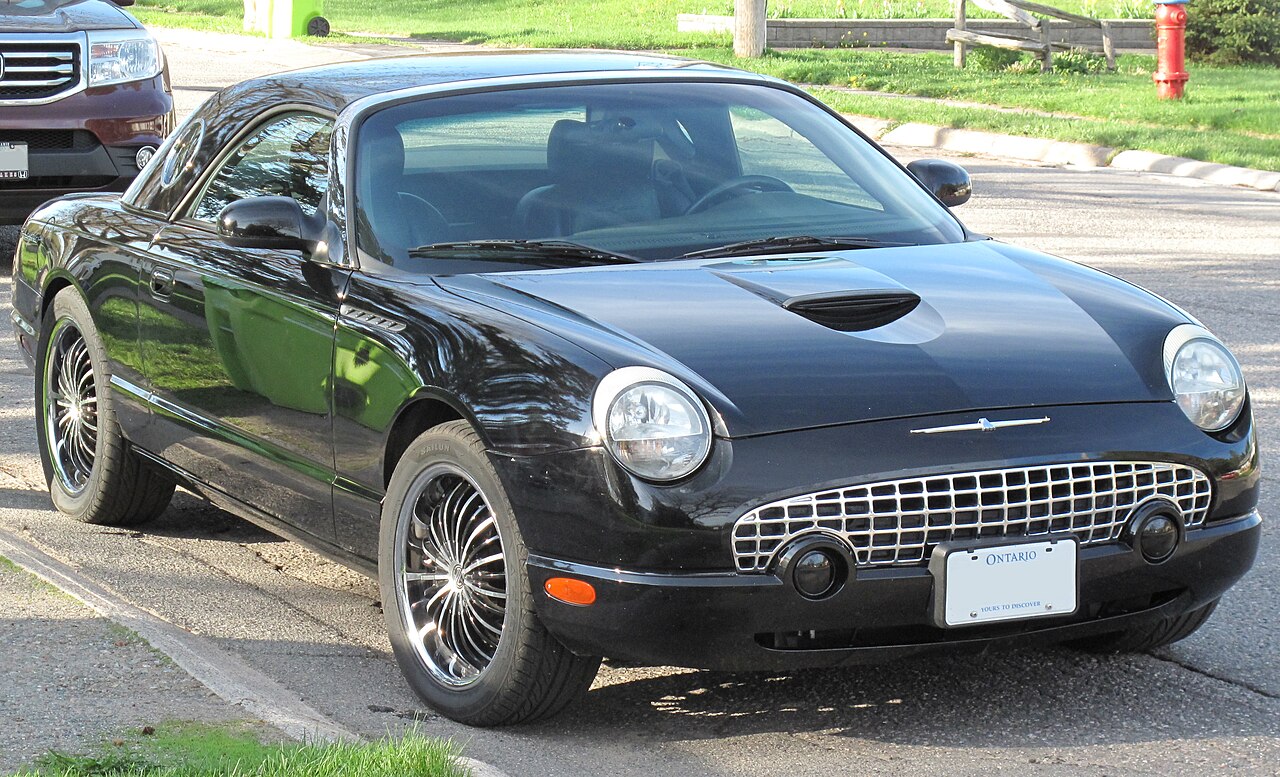 Elise240SX, CC BY-SA 4.0, Wikimedia Commons
Elise240SX, CC BY-SA 4.0, Wikimedia Commons
Fading Fast
A Jaguar DOHC 3.9-liter AJ-30 V8 offered 252 horsepower (its successor, the AJ-35, would put out 280). Customers were interested in the retro look the first year, but then sales dropped. Ford gave up on the retro Thunderbird with the 2005 model—and an American classic flew off into the sunset.
Two-For-One Special
“Sports-car personality combined with luxury-car roominess and comfort!” That’s how a brochure for the 1959 model described the way the Thunderbird offered the best of both worlds. And to a large extent, it succeeded, even if it seemed to lose its way as it got bigger and bigger.
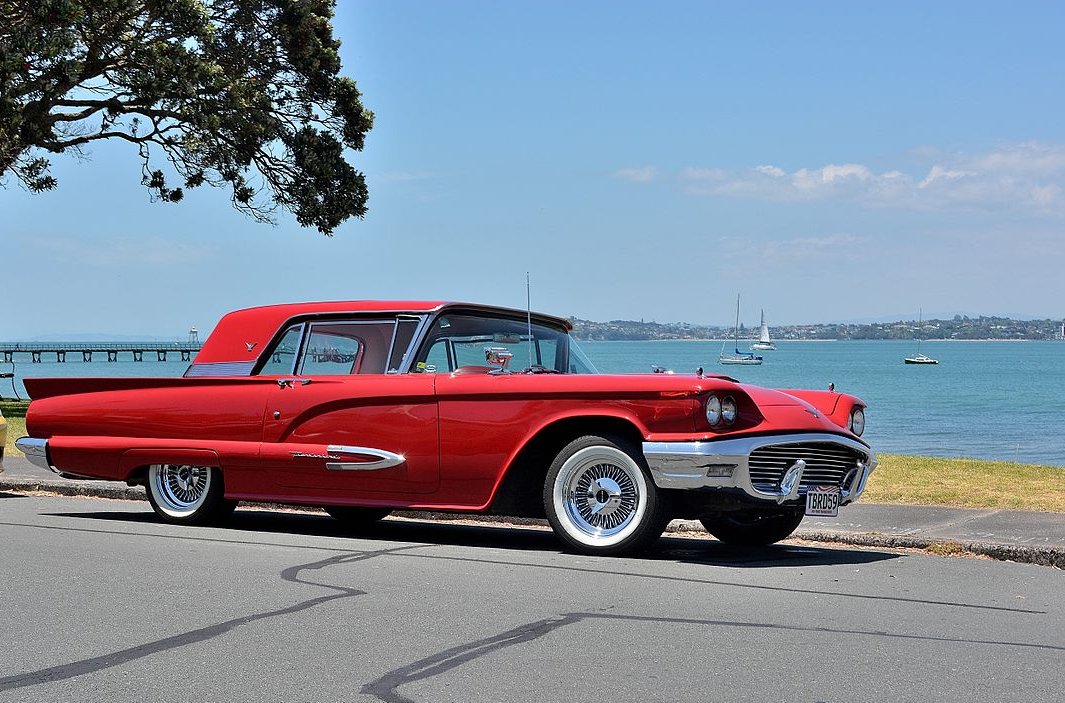 GPS 56, CC BY 2.0, Wikimedia Commons
GPS 56, CC BY 2.0, Wikimedia Commons
Flying High, Ending Low
So the Ford Thunderbird had a good run, defining the “personal luxury car,” at least for a decade or two. But it sure looked bloated when gas hikes forced a downsize—and a diminished, underpowered Thunderbird developed a shrunken reputation that was just too hard to shake.
You May Also Like:
Why The Ford Mustang II Flopped So Hard
The Reign Of The Chevrolet Impala


